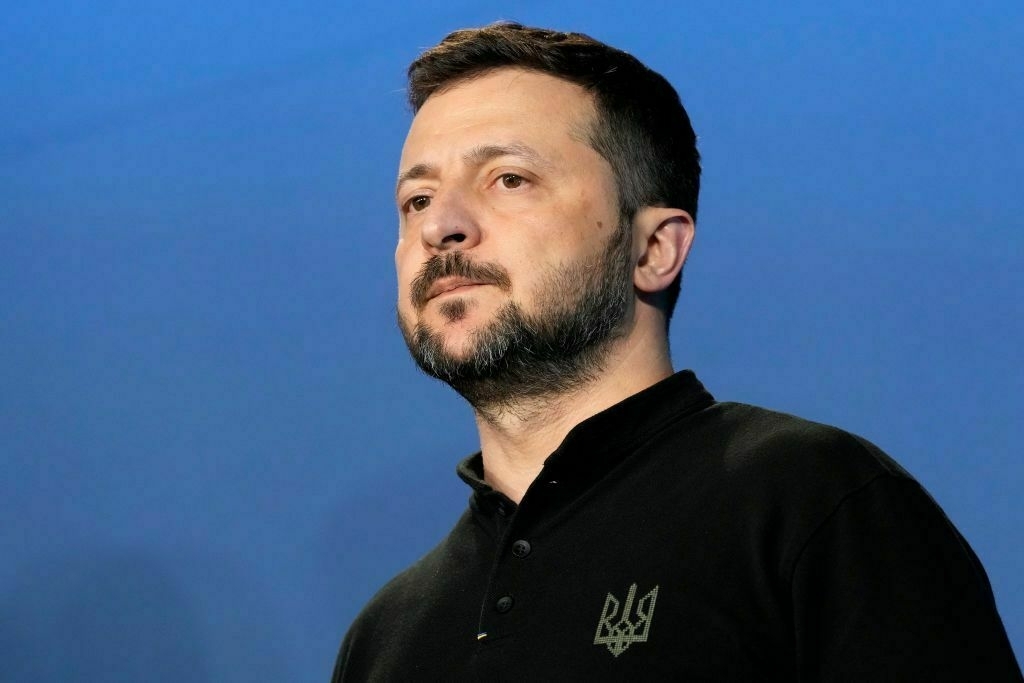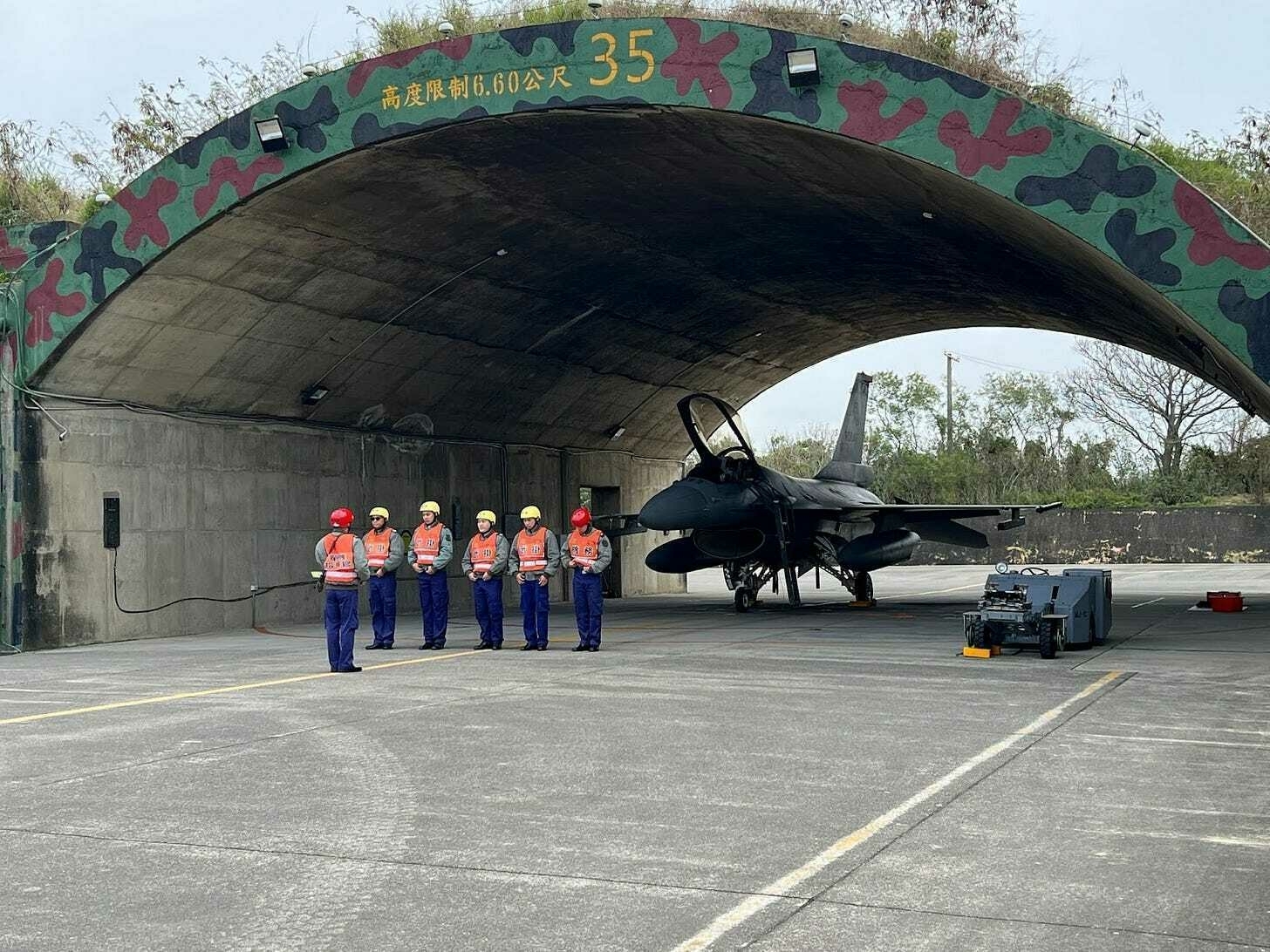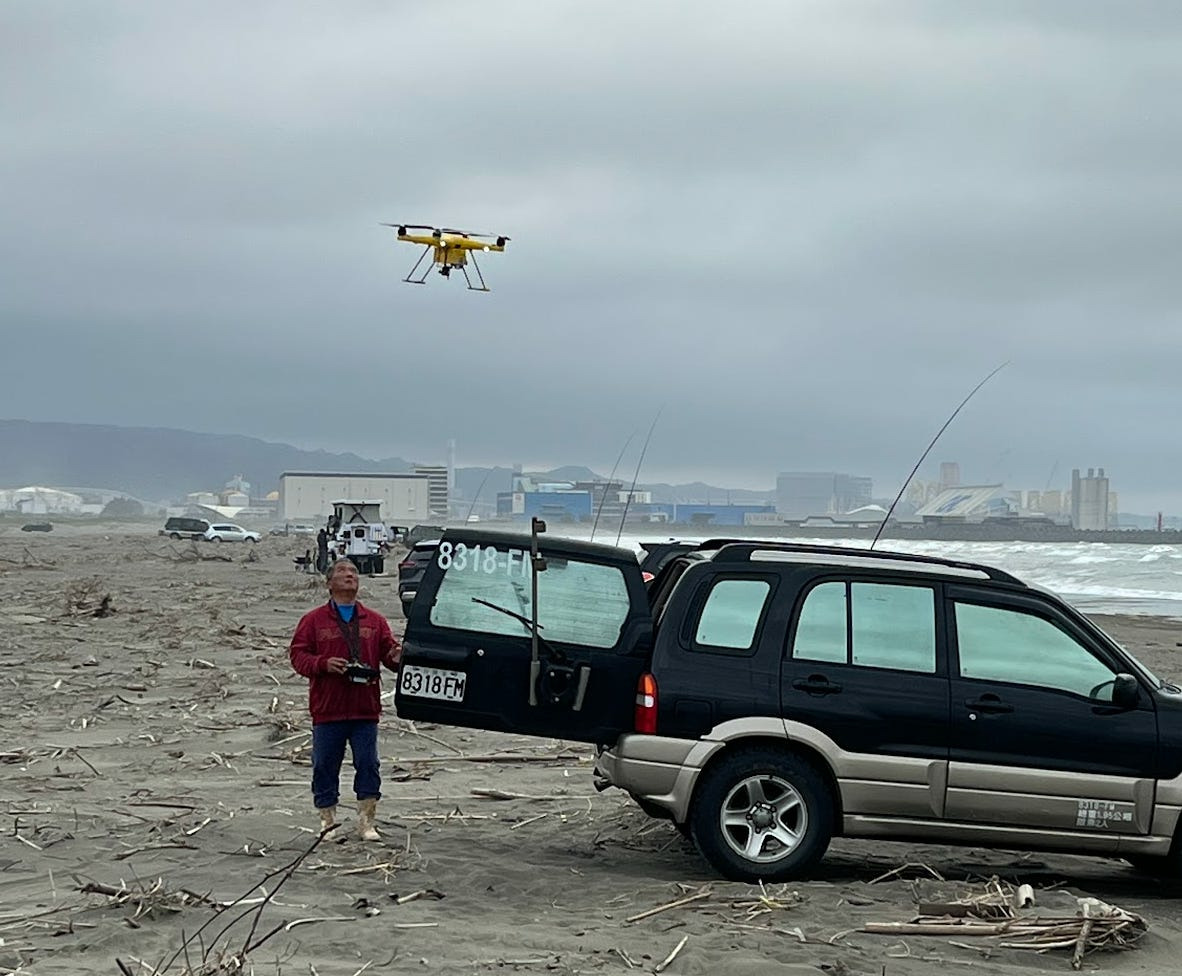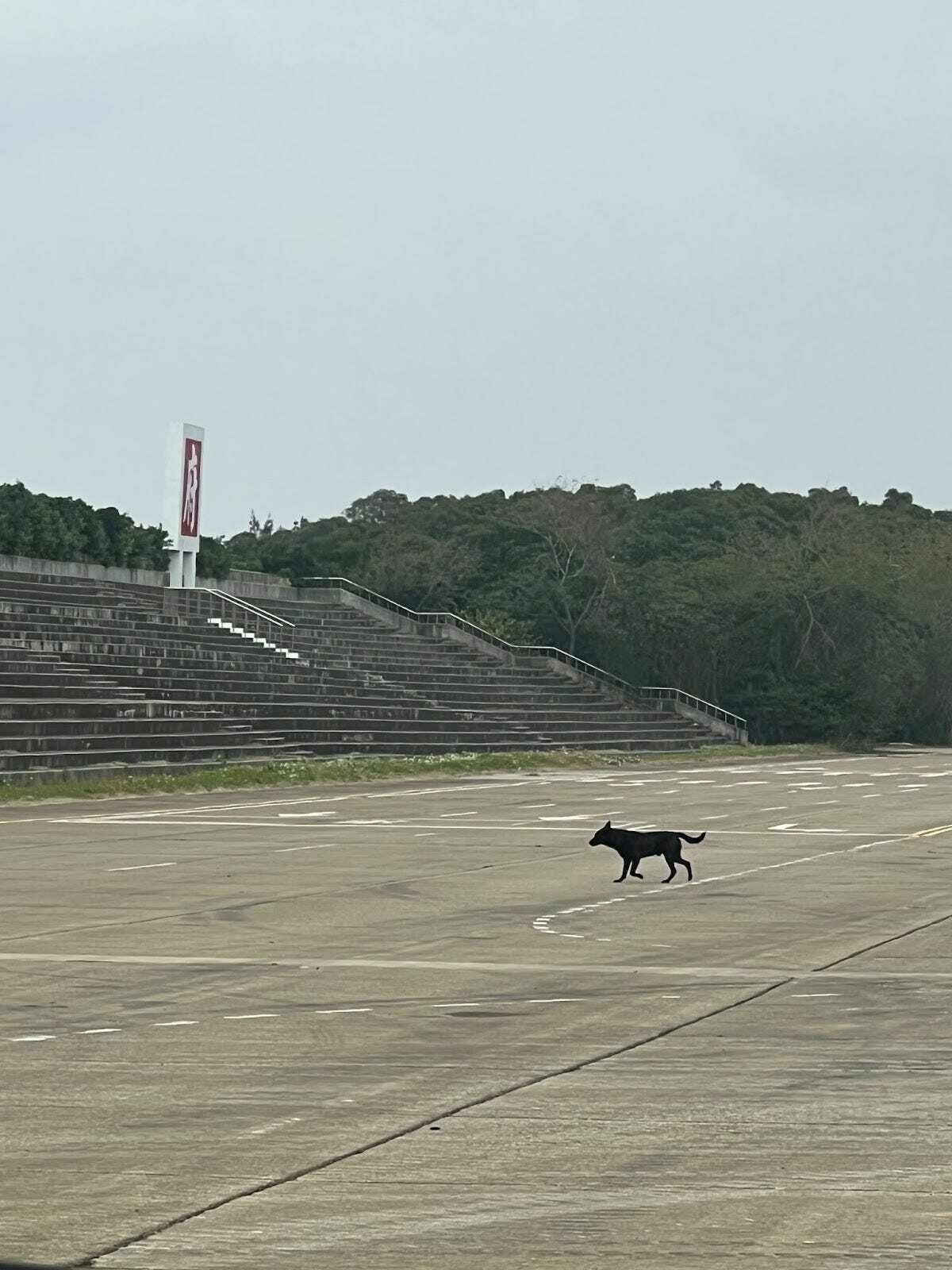-
Berlin wants more defense, no budget hike in EU plan, FT reports
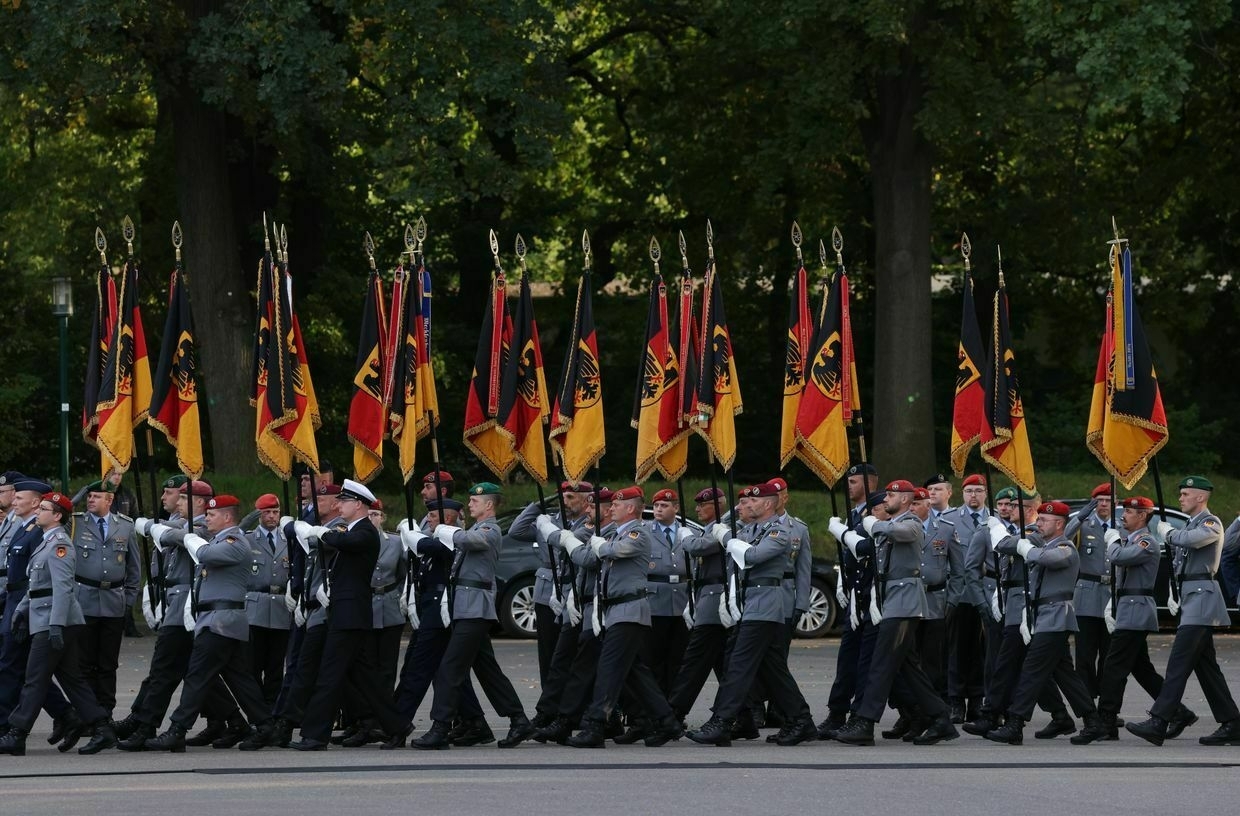
Germany aims to prioritize defense spending in the next EU budget while firmly opposing any increase in national contributions, according to a position paper obtained by the Financial Times (FT).
As the bloc’s largest economy and top net contributor, Berlin wants EU funds to support joint arms procurement and help expand production capacity among European weapons manufacturers.
The paper reportedly reflects Germany’s broader shift toward higher domestic military spending in response to Russia’s ongoing threat and amid calls by U.S. President Donald Trump for Europe to shoulder more of its own defense.
Berlin argues the EU budget should also fund dual-use technologies, military transport corridors, and other security-related initiatives despite current treaty restrictions on defence spending from the common budget, according to FT.
To free up funds for these priorities, Germany proposes cutting administrative costs and simplifying the EU budget structure. The government supports reducing the number of programes, granting the European Commission more flexibility to shift funds, and focusing spending on strategic areas such as cross-border infrastructure, energy security, digitalisation, and innovation.
Germany also opposes any extension of the EU’s post-Covid joint borrowing programme, stressing that repayments for the 800 billion euro fund must begin in 2028 as scheduled. While Berlin is open to discussing new EU-level revenue sources such as a carbon border levy or minimum corporate tax, it continues to reject an increase in direct national contributions to the budget, which currently total about 1% of EU GDP.
High stakes, low resolve: What Ukraine can expect from the upcoming G7 Leaders’ SummitAs world leaders prepare to gather in the remote community of Kananaskis in Alberta, Canada for the Group of Seven (G7) Leaders’ Summit on June 15-17, Russia’s war in Ukraine once again holds center stage — but views on how to address the three-year conflict diverge sharply. In the five monthsThe Kyiv IndependentDmytro Basmat
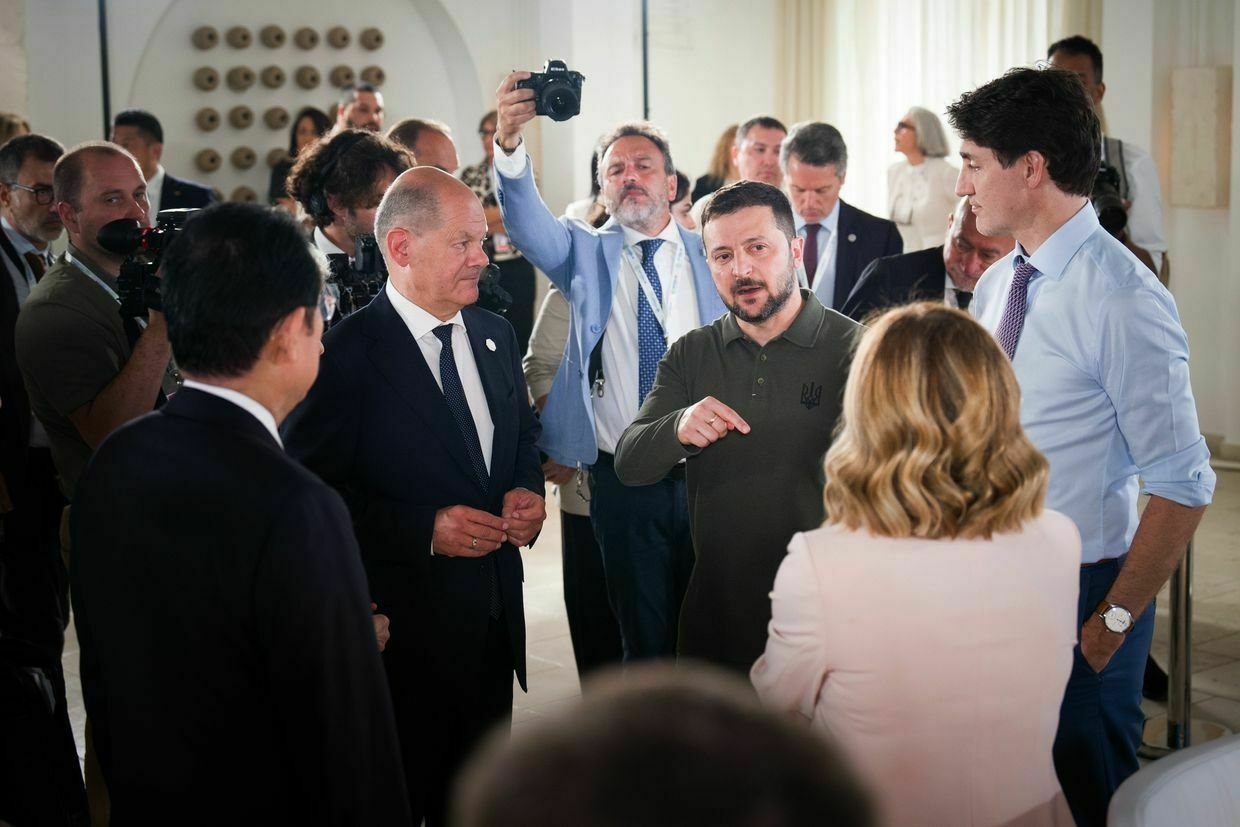
-
High stakes, low resolve: What Ukraine can expect from the upcoming G7 Leaders' Summit
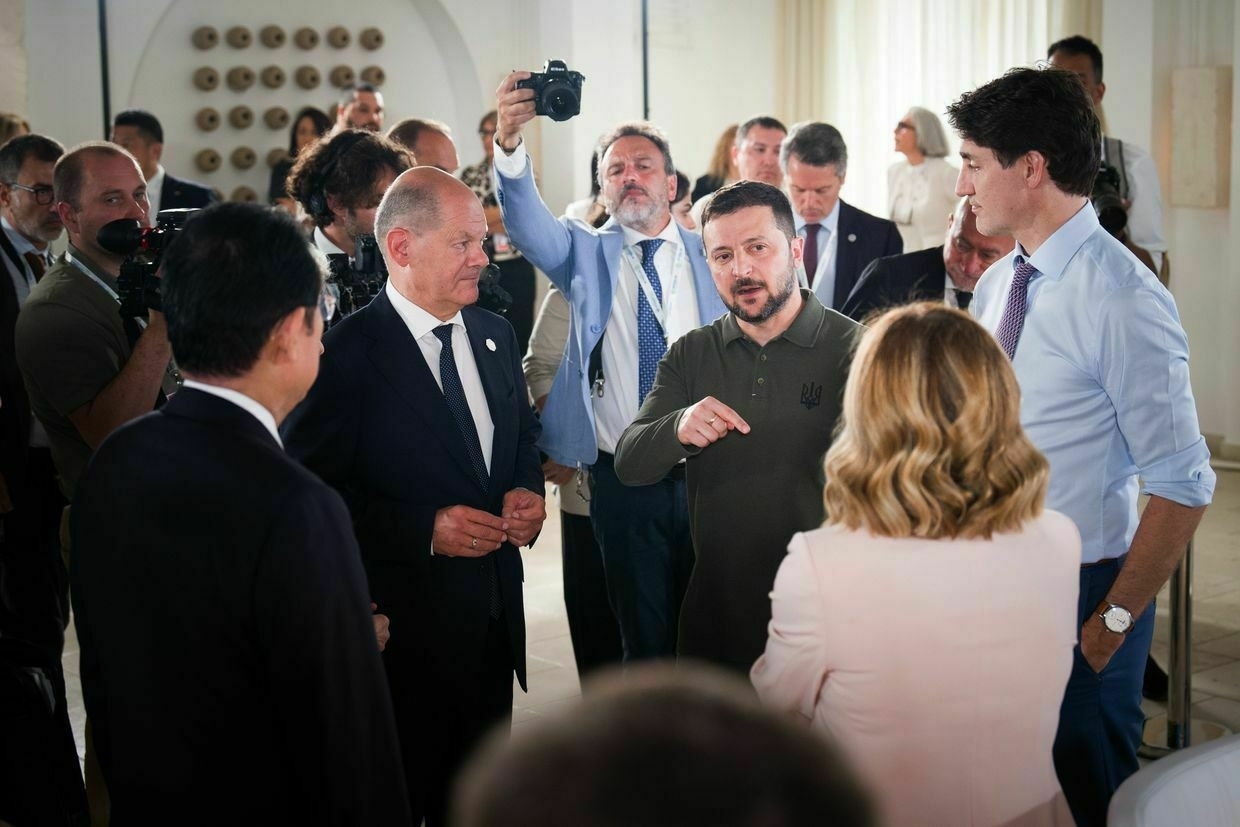
As world leaders prepare to gather in the remote community of Kananaskis in Alberta, Canada for the Group of Seven (G7) Leaders' Summit on June 15-17, Russia’s war in Ukraine once again holds center stage — but views on how to address the three-year conflict diverge sharply.
In the five months since U.S. President Donald Trump’s second term began, the G7’s core principle of unity and collective action has continued to break down amid Washington’s muted response to Russian aggression.
Canada, which holds the G7 presidency in 2025, invited President Volodymyr Zelensky to participate in what will be his fourth — and arguably most fragile — G7 Leaders' Summit since the outbreak of the full-scale invasion in 2022.
As deadly attacks on Ukrainian cities intensify night after night, Zelensky will be tasked with attempting to hold together international support for Kyiv while advocating for more punitive measures against Moscow.
For Zelensky, the summit marks an opportunity to revitalize Western support for sanctions against Russia, impose punitive economic pressures on Russia’s war machine, and potentially rekindle relations with Trump in a pivotal face-to-face meeting.
A high-stakes Zelensky-Trump meetingZelensky is expected to meet with Trump on the sidelines of the G7 summit on June 17, marking their third in-person meeting since the American president took office in January. The proposed meeting may serve as an inflection point for Zelensky as pressure mounts on Trump from Western allies.
“Both teams are working to ensure we meet,” Zelensky said on June 14 during a closed-door briefing attended by the Kyiv Independent.
After a disastrous first in-person meeting between the two leaders in the Oval Office in February — during which Trump and Vice President JD Vance lambasted Zelensky over what they described as “a lack of gratitude for U.S. support” — a second meeting in a neutral setting helped smooth over tensions.
After speaking with Trump at the Vatican following the funeral of Pope Francis in early May, Zelensky praised their short, yet "most substantive" conversation.
"With all due respect to our teams, the one-on-one format, in my opinion, worked. We had the right atmosphere for the conversation," Zelensky said after the talk.
Following the Vatican talks, Trump reiterated calls for a Russian ceasefire, even threatening to impose sanctions on Russia — a strikingly different tone than after his initial Oval Office meeting with the Ukrainian president.
In the month since their last in-person meeting, tensions between Trump and Zelensky have risen again. Despite his threats, Trump has not followed through on implementing additional economic pressure on Moscow.
On June 12, Zelensky decried Washington's lack of urgency around sanctions, suggesting that Russia is "lying to Trump." He said that Russian President Vladimir Putin's strategy is to maintain the illusion of dialogue without ever committing to a ceasefire.
Trump gave Putin a ‘two-week’ deadline to consider peace in Ukraine. Instead, Russia just launched more drones.A “two week” deadline imposed by U.S. President Donald Trump to see if Russia is serious about peace in Ukraine has come and gone, with Moscow’s escalation of attacks on civilians during this period failing to draw the slightest condemnation from the White House. “We’re going to find outThe Kyiv IndependentYuliia Taradiuk
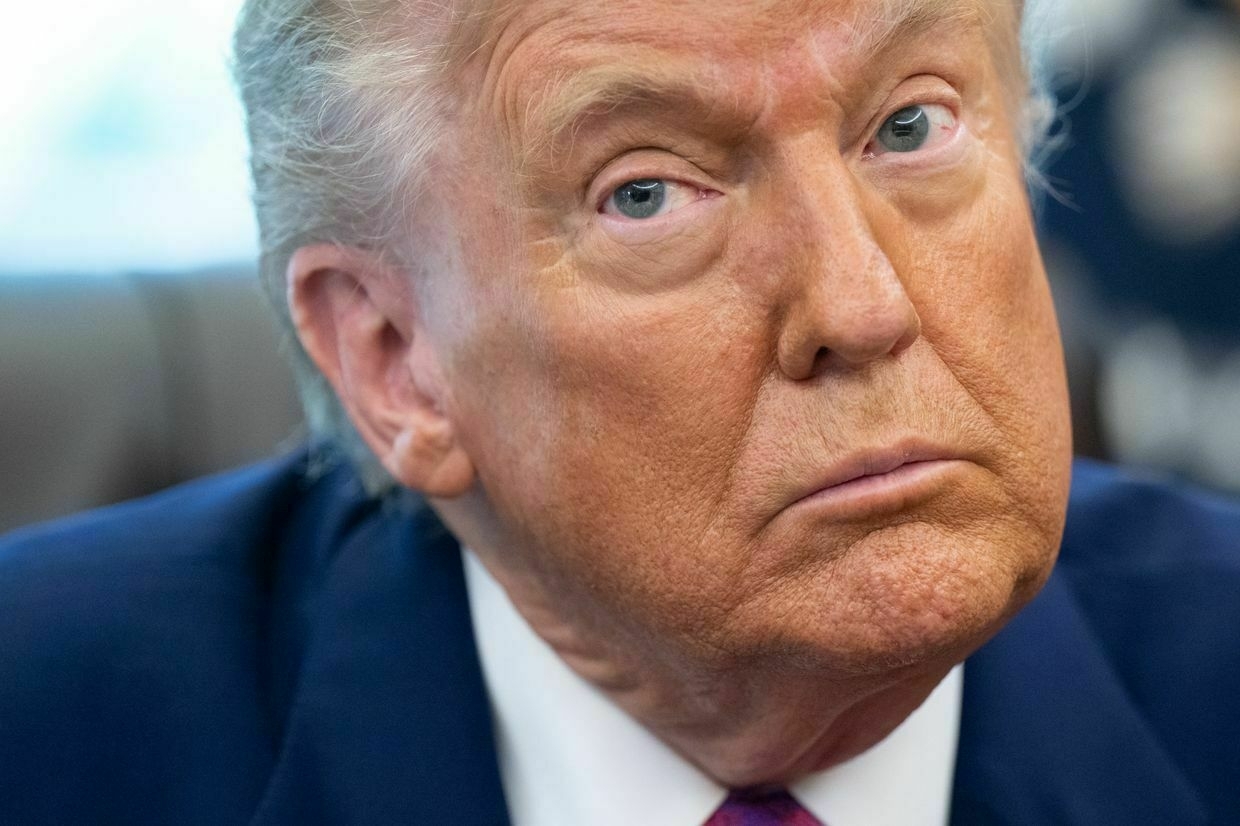
Adding to the anxiety is the Trump administration's lukewarm commitment to military support for Ukraine.
U.S. Defense Secretary Pete Hegseth recently announced that the Pentagon will reduce funding allocated for military assistance to Ukraine in its 2026 defense budget — a decision that Ukrainian lawmakers have warned could have "dire consequences" on the battlefield.
With Trump openly questioning continued U.S. support for Ukraine as well as NATO commitments, his policies have already begun to reshape G7 leaders' strategic calculations — especially when it comes to long-term security guarantees for Kyiv.
"The approach to implementing President Trump's policies is characterized by chaos and uncertainty," political analyst and associate professor at Taras Shevchenko National University Yaroslav Teleshun said.
"But chaos, under certain circumstances, is also a tool that can either accelerate or slow down various processes, or even radically change them. The key question is to what extent Ukraine and members of the club of great powers are ready to work with this and use it to their advantage," Teleshun told the Kyiv Independent.
In the meantime, Trump admitted on social media that he has been sheltering Russian from facing serious consequences as a result of his lack of action — even encouraging Senators to postpone and soften Congress' sanctions bill against Russia.
"What Vladimir Putin doesn't realize is that if it weren't for me, lots of really bad things would have already happened to Russia, and I mean really bad. He's playing with fire," Trump wrote on May 27.
Zelensky's third opportunity at talks comes at a critical crossroads in U.S. support for Ukraine. Another high-stakes meeting with Trump could once again change the tenor of relations between the two leaders — for better or worse.
From buffer zone to new front: Russia pushes deeper into Sumy OblastIn March 2025, as Ukrainian forces made their final retreat from Sudzha in Russia’s Kursk Oblast, new grey spots began to appear on open-source maps on the other side of the state border, in Ukraine’s Sumy Oblast. For the first time since 2022, when Moscow’s forces retreatedThe Kyiv IndependentFrancis Farrell
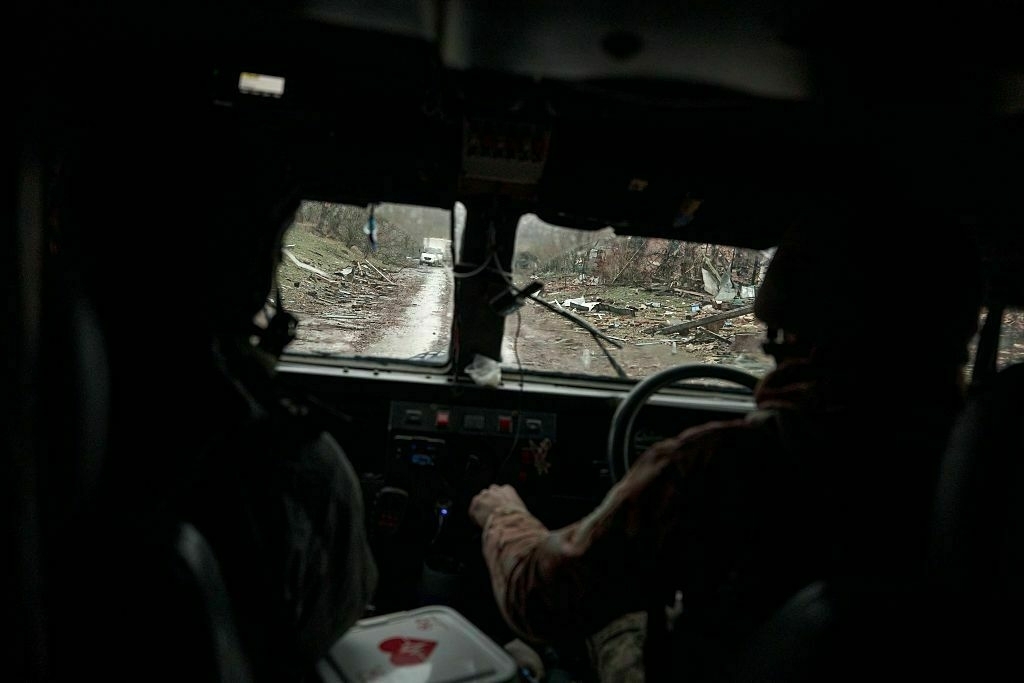
Putting pressure on Russia's war machineWith Trump in power, G7 consensus on the war in Ukraine is collapsing — and with it, the hope of unified economic action against Russia. Zelensky will likely find himself advocating for the type of coordinated response that hasn't been seen since the Biden administration.
While the European Union plans for the implementation of an 18th sanctions package against Russia on energy, banking, and oil, Trump refuses to set a deadline as to when the U.S. can be expected to impose additional sanctions.
Trump has repeatedly threatened to impose sanctions on Russia if he does not see progress in peace talks between Kyiv and Moscow — and repeatedly failed to follow through on these threats.
Despite Russia's rejection of a ceasefire, Trump has said he hasn't imposed new sanctions because he believes a peace deal might be within reach.
"If I think I'm close to getting a deal, I don't want to screw it up by doing that," he said on May 28, adding that he is prepared to act if Moscow stalls further.
While Trump has admitted that Russia may be "tapping me along," he refuses to impose sanctions as it may hinder future business and trade opportunities with Moscow, according to the New York Times.
Trump's comments heavily differ from those of his European allies, who, for the most part, support additional economic pressure on Moscow.
"Russia's goal is not peace," European Commission President Ursula von der Leyen said in pushing for consensus on additional sanction on Russia at the upcoming G7 meeting. "Strength is the only language that Russia will understand."
In addition to sanctions, proposed changes to the oil price cap will also be discussed.
Russia's Finance Ministry has leaned on oil and gas taxes to finance growing military expenditures. The current G7 price cap bans Western companies from shipping, insuring, or otherwise servicing Russian oil sold above $60 per barrel, limiting the country's revenue from oil exports.
The EU has called for the G7 to agree to the reduction of the oil price cap from $60 to $45 per barrel.
For his part, Zelensky called on June 10 for the price cap to be "stronger," proposing to lower it from $60 to $30 per barrel in order to pressure Moscow to declare a ceasefire.
"A ceiling of $45 per barrel of oil is better than $60, that's clear, that's true. But real peace will come with a ceiling of $30," Zelensky said. "That's the level that will really change the mindset in Moscow."
Key to Russia’s defeat lies in its economyAs the war in Ukraine grinds on, attention remains fixed on the battlefield. But Russia’s most vulnerable flank is not in the trenches — it’s in the treasury. The West, and especially the United States, holds economic levers that could push Vladimir Putin toward serious negotiations or even collapseThe Kyiv IndependentWojciech Jakóbik
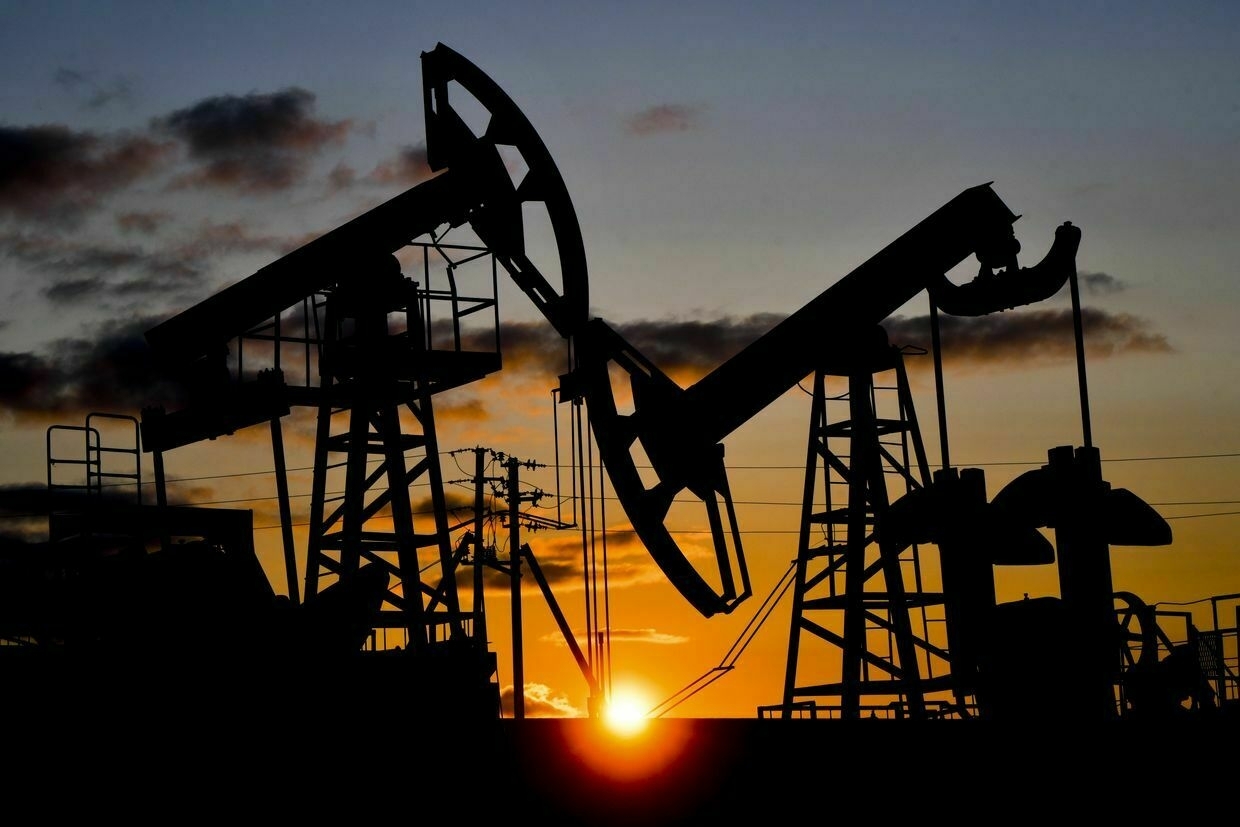
While U.S. officials have not publicly commented on renewed efforts to reduce the price cap, the U.S. opposed a joint G7 effort at the finance ministers meeting in May to lower the cap after U.S. Treasury Secretary Scott Bessent reportedly declined to support it.
In a preview of the potential battle to come over the price cap, Reuters reported on June 12 that G7 nations are prepared to lower the Russian oil price cap from $60 to $45 a barrel even without support from the United States.
The upcoming summit will mark a rare opportunity for Zelensky to advocate for punitive economic measures on Russia in face-to-face meetings with world leaders, encouraging any holdouts to take additional measures.
G7 of disunity?Unlike the European Union — which legally requires unanimous consent to enact certain measures, such as sanctions — the G7 relies on informal consensus to make an impact on the global economy.
At past G7 summits, joint communiques at the conclusion of meetings have made significant impacts on Russia and Ukraine.
The $60 price cap on Russian oil was jointly introduced by the G7 and EU in December 2022. Similarly, G7 nations finalized a framework agreement for a $50 billion loan for Ukraine backed by frozen Russian assets during the 2024 G7 Leaders' Summit in Italy.
While the G7 has a strong record of progress in supporting Ukraine through economic policy, next week's summit will serve as a major test of resolve for the bloc's collective unity.
Political analyst Teleshun says the G7 Summit is unlikely to be defined by joint declarations, but rather by attempts to navigate a new mode of cooperation among partners. The main goal of the summit, according to him, will be not so much to agree on joint statements as to find possible effective forms of further coexistence between partners.
Ukraine, he adds, will remain a central — and paradoxical — issue: one that both unites and divides. While decisions on future military aid may ultimately be left to individual governments, Kyiv can still use this moment to its advantage. Tightening sanctions against Russia, for instance, could serve as a unifying initiative for G7 countries, but it will require sustained diplomatic effort.
The U.S. objected on May 21 to the inclusion of clauses on "further support" for Ukraine in a joint statement during the precursor meeting of G7 finance ministers. Washington also refused to label Russia's full-scale invasion of Ukraine as "illegal" in the text, according to sources who spoke to Politico.
As Ukraine continues to hold the line against Russia's grinding advances, signs of disunity among Western allies will likely affect Kyiv's ability to fight back against Moscow's forces — and likely embolden Moscow's territorial ambitions.
The G7 summit will once again serve as an indicator for Putin as to what kind of collective response may be expected if he is to pursue additional territorial gains. For Ukraine, the summit will be indicative of the level of unified support it can expect from the U.S. and allies as the war rages into its fourth year.
Olena Goncharova contributed reporting.
NATO summit statement omits Ukraine’s entry bid, $40 billion pledge, Bloomberg reportsThe unusually brief document recognizes Russia as a threat to NATO but not as an aggressor in Ukraine.The Kyiv IndependentMartin Fornusek
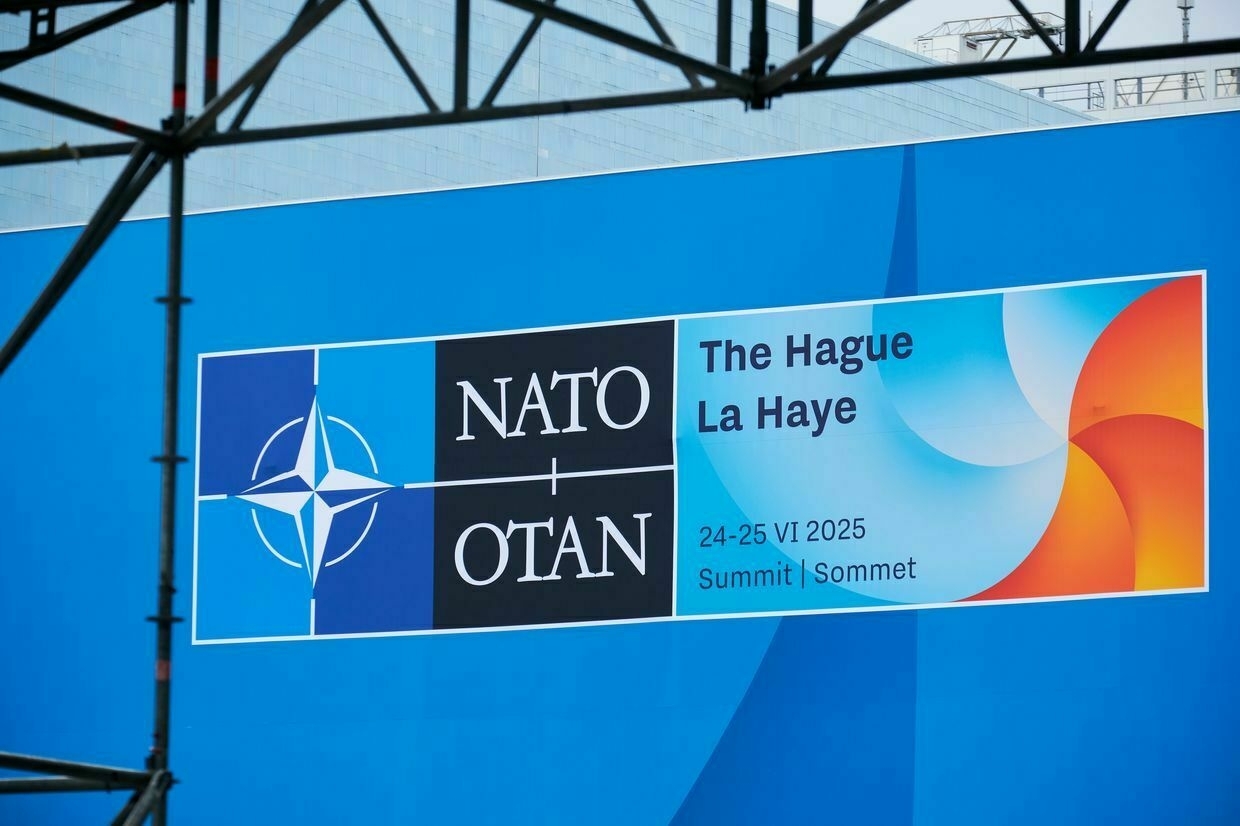
Note from the author:
Hey there, it's Dmytro Basmat, the author of this piece. I'm looking forward to bring you live breaking news coverage from the G7 Leaders' Summit in Canada. My colleagues and I are working around the clock on the ground in Kyiv and overnights in North America to bring you the latest updates on the war in Ukraine. I hope you'll consider supporting us by becoming a paid member of the Kyiv Independent today to help deliver the facts about the war in Ukraine to readers around the world.
-
Russia transfers 50 Ukrainian children to so-called 'rehab camp' in Kalmykia, Kyiv says

Russia has transferred 50 children from the occupied Antratsyt district of Luhansk Oblast to a so-called rehabilitation camp in Kalmykia, Ukraine’s Center for Countering Disinformation (CCD) reported on June 14.
Kalmykia is about 1,170 km (726 miles) by air from Moscow, and its western border lies roughly 300 km (186 miles) from the nearest point on the Russia–Ukraine border.
According to the center, while the “Lesnaya Skazka” (“Forest Fairy Tale”) camp is officially described as hosting sports and creative activities, in fact, it functions as a site of “round-the-clock ideological brainwashing, systemic Russification, and an attempt to erase Ukrainian identity."
Since February 2022, at least 20,000 Ukrainian children have been abducted from Russian-occupied territories and sent to other Russian-controlled areas of Ukraine or to Russia itself, according to a Ukrainian national database, “Children of War.” Only 1,359 children have been returned thus far.
The center compared the camp in Kalmykia to “Krasnaya Gvozdika,” (“Red Carnation”) a facility in occupied Zaporizhzhia Oblast, saying both are used not for recreation, but as tools of Russia’s war strategy.
“These camps have become instruments of assimilation where Ukrainian children are taught distorted history, exposed to Russian propaganda, and conditioned to show loyalty to the Putin regime,” the center said. “War and hostility are normalized, with children being groomed as human resources for future conflicts.”
The watchdog emphasized that separating children from their families, culture, and language places them under the full control of the occupying power — a practice it says constitutes a violation of international humanitarian law and forms part of Russia’s broader genocidal policy toward Ukraine.
In response to Russia’s efforts to indoctrinate Ukrainian children, President Volodymyr Zelensky on June 10 imposed sanctions on 48 individuals and nine organizations associated with the deportation of Ukrainian children, according to a decision of Ukraine’s National Security and Defense Council (NSDC).
Growing up under missiles — Ukrainian childhoods shaped by war (Photos)Ukrainian children are growing up in a world entirely reshaped by Russia’s war. Sirens, blackouts, and bomb shelters are nothing extraordinary — but a part of everyday childhood. This photo story follows five families as they raise their children in the shadow of the ongoing invasion. It’s not aboutThe Kyiv IndependentElena Kalinichenko
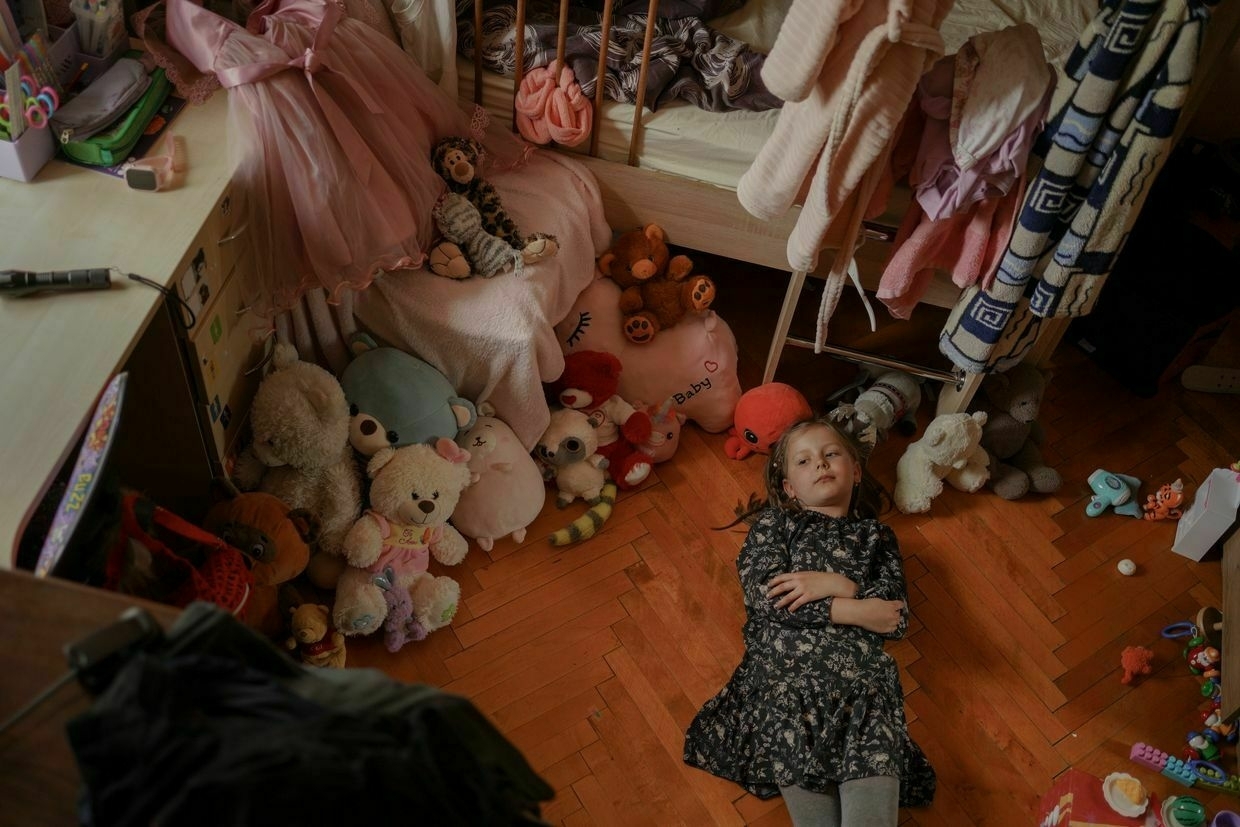
-
Israel asks US to join strikes on Iran’s nuclear sites, officials told Axios
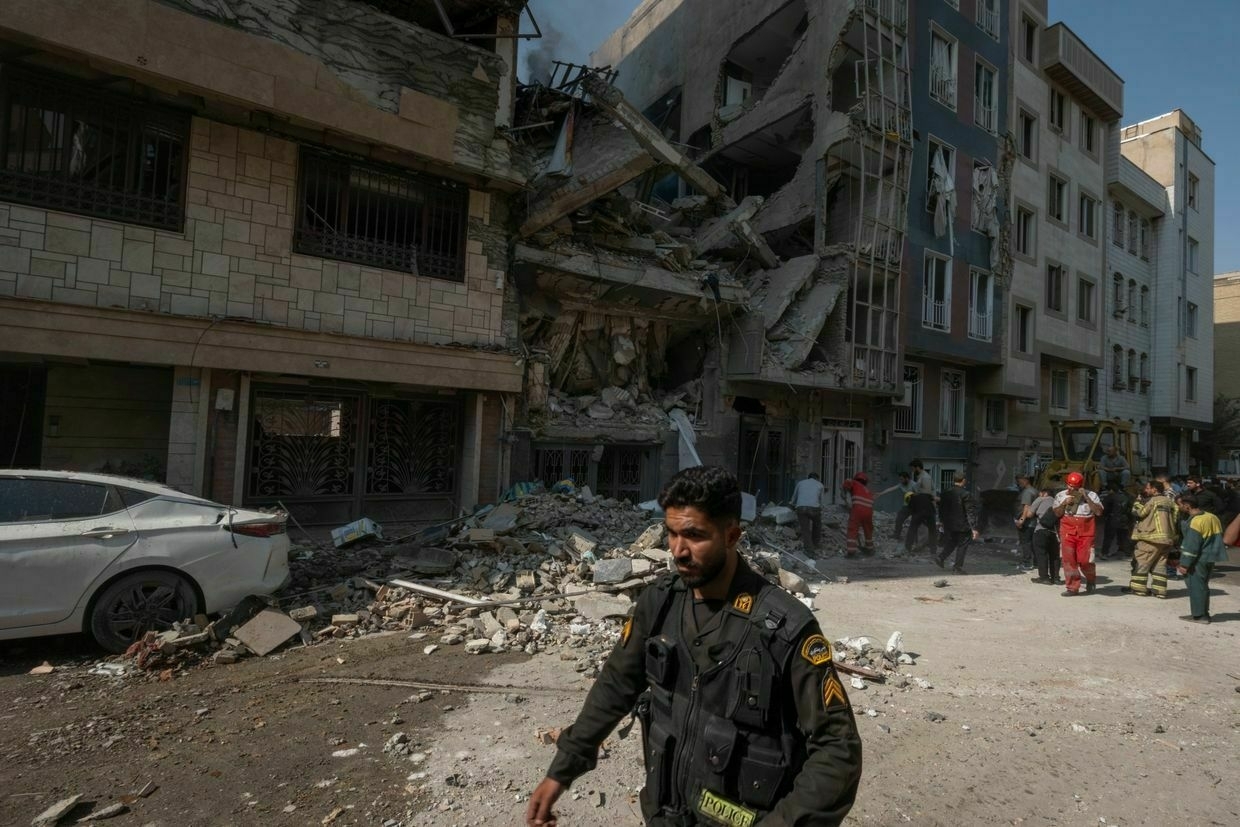
Israeli officials have asked the Trump administration to join military operations targeting Iran’s nuclear program, including a strike on the fortified Fordow uranium enrichment site, Axios reported on June 14, citing two Israeli officials.
The request comes as Israel continues its assault on Iranian targets and warns that it lacks the capability to destroy Fordow alone. The underground facility, located deep within a mountain, is beyond the reach of Israel’s conventional weapons. U.S. forces in the region, however, have the necessary bunker-busting bombs and bomber aircraft to hit the site.
According to an Israeli official who spoke to Axios, Trump suggested in a recent conversation with Israeli Prime Minister Benjamin Netanyahu that he would consider joining the operation if needed. But a White House official denied that claim on June 13.
A second U.S. official confirmed that Israel had urged the U.S. to take part, but said the administration is not currently considering involvement. Israeli Ambassador to the U.S. Yechiel Leiter told Fox News on June 13 that “the entire operation… really has to be completed with the elimination of Fordow."
An Israeli source told Axios that the U.S. is considering the request, and that Israel hopes Trump will agree to it.
A senior White House official told Axios on June 14 that “whatever happens today cannot be prevented,” referring to the Israeli attacks. “But we have the ability to negotiate a successful peaceful resolution to this conflict if Iran is willing. The fastest way for Iran to accomplish peace is to give up its nuclear weapons program,” the official added.
U.S. officials have so far maintained that Iranian retaliation must not target American forces, arguing that the current Israeli operation does not justify attacks on U.S. interests.
Israel-Iran war could provide economic boost Russia needs to continue fight against UkraineIsrael’s “preemptive” strikes against Iran targeting the country’s nuclear program and killing top military officials could have far-reaching implications for Ukraine and could boost Russia’s ability to continue its full-scale invasion, experts have told the Kyiv Independent. Iran has been one of Russia’s staunchest allies throughout the war, providing thousandsThe Kyiv IndependentChris York
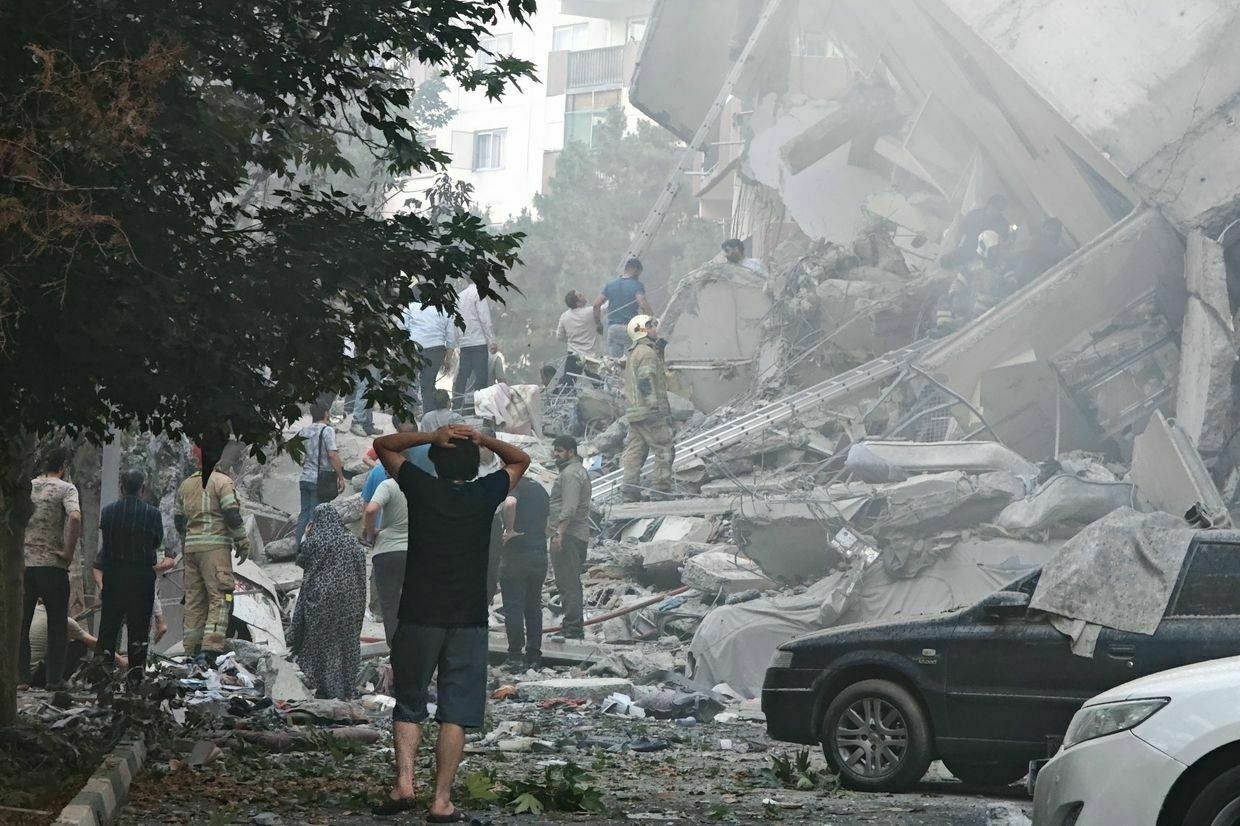
-
Kyiv Pride march takes place, gathers international representatives, faces counterprotesters
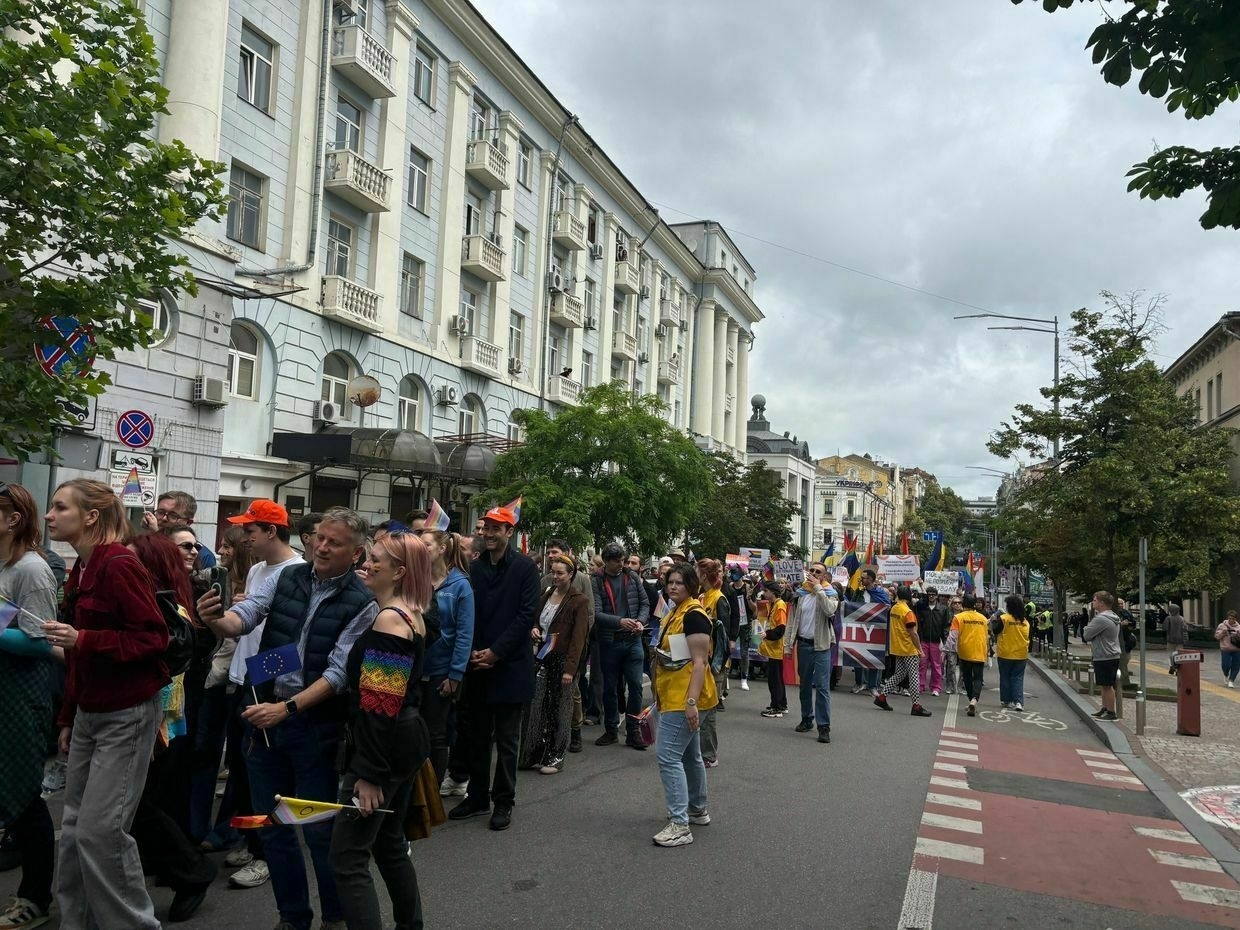
Kyiv Pride held a parade with over 1,500 participants in the Ukrainian capital on June 14, which was met with counterprotests.
“Other Ukrainian Prides also participated — including Kharkiv Pride and Ukraine Pride. Kyiv’s student community was represented, among others, by the Student Parliament of Taras Shevchenko National University of Kyiv and Ukraine Global Scholars,” Kyiv Pride said in a post to Facebook.
On June 7, a drone charity event for Kyiv Pride took place outside the Foreign Ministry building and was met with a nearby counterprotest.
The march was joined by representatives from the EU, Canada, the U.K., and various other countries, including France, Germany, and Spain.
The march was joined by the LGBT+ Military non-governmental organization (NGO) as Russia’s war against Ukraine continues.
“Among the marchers was veteran Viktor Pylypenko, head of the NGO LGBT+ Military for Equal Rights. He drew public attention to the growing loss of military personnel and veterans who are dying at war — while their families remain unrecognized by law,” Kyiv Pride said in its statement.
The march raised 20,000 hryvnia for the Serhiy Sternenko Foundation to purchase drones for the military.
Representatives, including Canada’s ambassador to Ukraine, Natalka Cmoc, joined the event.
“Ambassadors, the Canadian embassy team, along with many diplomats, joined (the) Kyiv Pride march this morning,” Cmoc said.
The Kyiv Pride event was met with a nearby counterprotest.
“With regret, we must note that those who incite violence still have broader access to public space and freely walk through the central streets, while participants of Kyiv Pride March are surrounded by police and restricted in their route. We continue to witness the spread of hate speech,” Kyiv Pride said.
Kyiv Pride held a march in June 2024 for the first time since Russia began its full-scale war against Ukraine in February 2022.
‘Europe hasn’t decided what to do if US steps back’ — key takeaways from Zelensky’s closed-door briefing“Both teams are working to ensure we meet,” President Volodymyr Zelensky said.The Kyiv IndependentAnna Fratsyvir

-
War between IRAN and ISRAEL – How will it impact the world and Ukraine? | Wrap-Up Weekly
-
Ukraine continues destroying Russian aviation: consequences of drone strikes #shorts
-
Ukrainian drones destroy Russian air defense systems in occupied Zaporizhzhia Oblast, military intelligence says
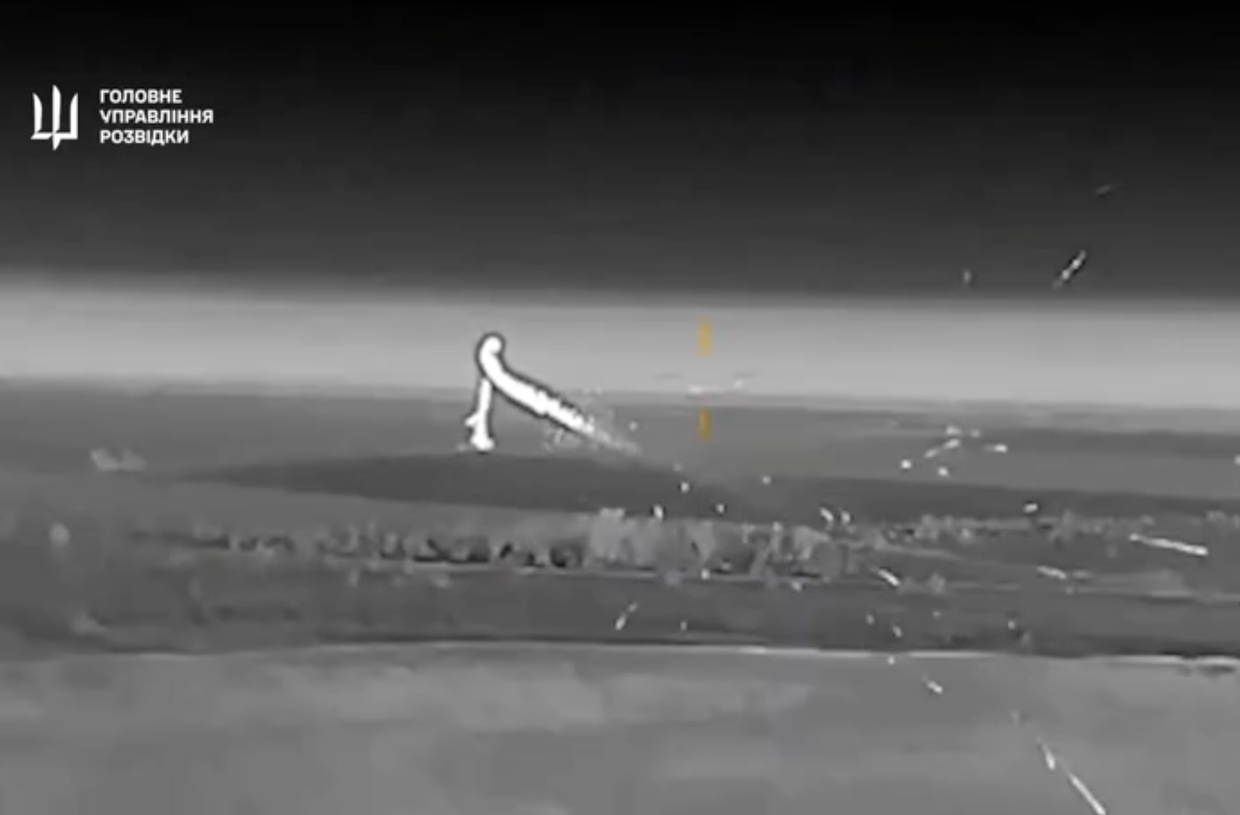
Ukraine’s military intelligence (HUR) destroyed three Russian air defense systems using drones in the occupied Zaporizhzhia Oblast on June 14, HUR says.
“Strike drone masters of the Department of Active Operations of the HUR of the Ukrainian defense ministry discovered and destroyed expensive air defense systems of the Russian invaders in the temporarily occupied territory of the Zaporizhzhia region,” HUR reported in a post to Telegram.
Ukraine’s military regularly strikes military targets in Russian-occupied territories and deep within Russia in an attempt to diminish Moscow’s fighting power as it continues its war against Ukraine.
A Russian Buk-M3, a Pantsyr S1, and a 9S19 Imbir radar from the S-300V air defense system were destroyed in the Ukrainian drone attack.
“The video shows a stunning maneuver of a Ukrainian drone dodging a Muscovite anti-aircraft missile, as well as episodes of successful fire strikes,” HUR’s statement said.
On June 1, Ukraine launched a game-changing drone attack on four key Russian military airfields, damaging 41 planes, including heavy bombers and rare A-50 spy planes.
Kyiv claimed it disabled 34% of Russia’s strategic bomber fleet in what is seen as one of the most daring operations during Russia’s full-scale war.
Ukraine’s military intelligence agency was behind explosions near Desantnaya Bay in Russia’s far eastern Vladivostok on May 30, which reportedly damaged military personnel and equipment, a source in HUR told the Kyiv Independent.
From buffer zone to new front: Russia pushes deeper into Sumy OblastIn March 2025, as Ukrainian forces made their final retreat from Sudzha in Russia’s Kursk Oblast, new grey spots began to appear on open-source maps on the other side of the state border, in Ukraine’s Sumy Oblast. For the first time since 2022, when Moscow’s forces retreatedThe Kyiv IndependentFrancis Farrell
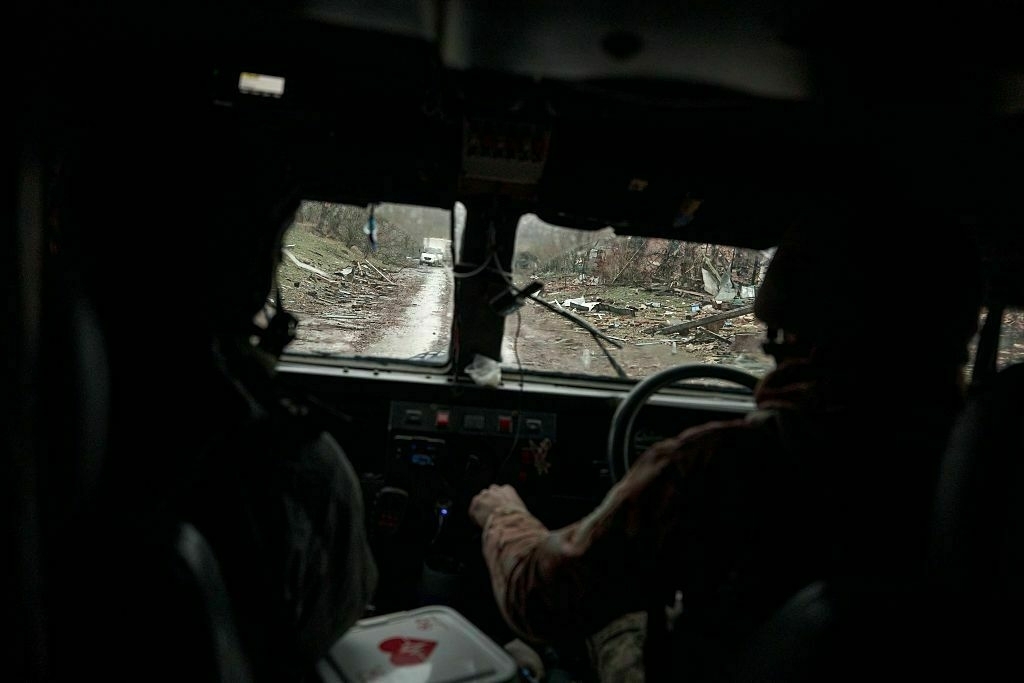
-
Putin, Trump hold phone call, Russia's Ushakov claims
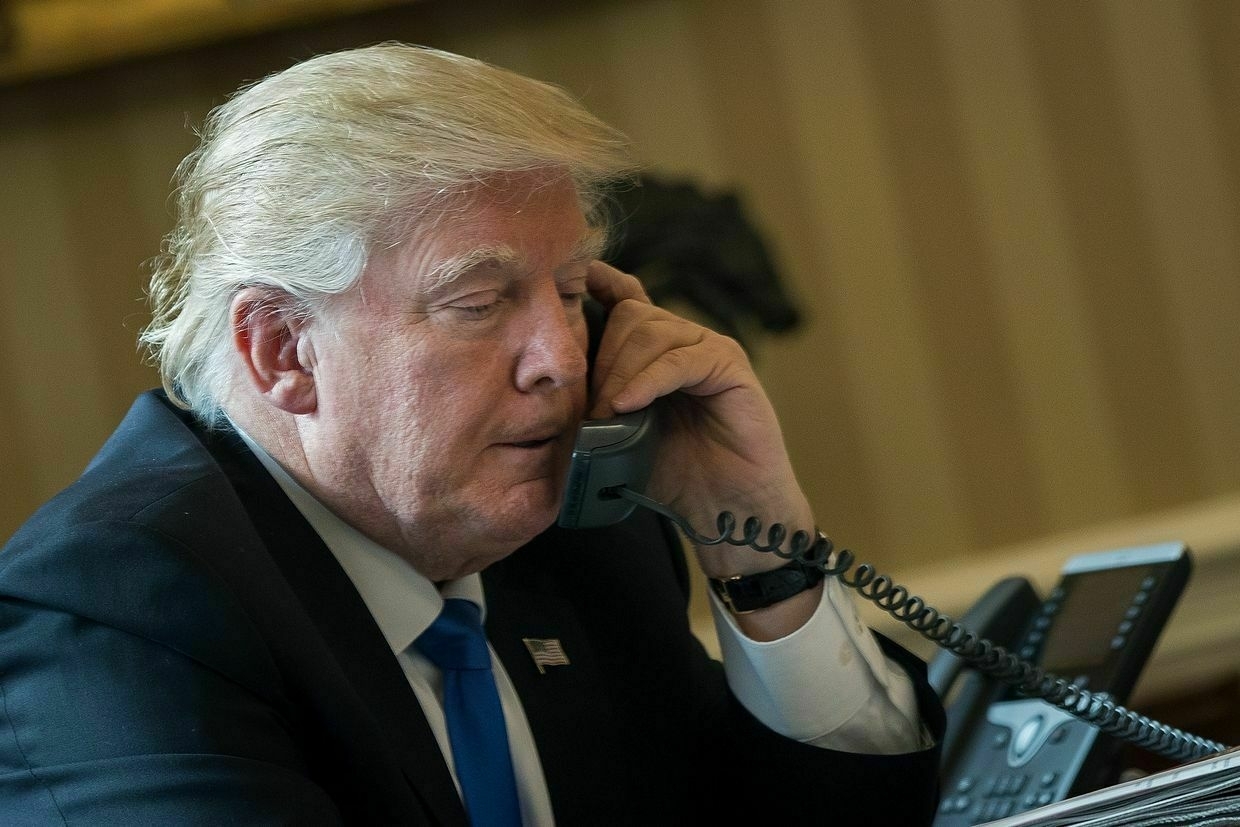
Editor’s note: This is a developing story and is being updated.
U.S. President Donald Trump and Russian President Vladimir Putin held a phone call, Putin’s foreign policy aide, Yuri Ushakov said on June 14.
“Another telephone conversation between Russian President Vladimir… Putin and U.S. President Donald Trump,” Russian state media reported, citing Ushakov.
The phone call took place on Trump’s birthday, as the U.S. president marks the occasion with a military parade in Washington.
Russia has intensified drone and missile attacks on Ukraine following two rounds of largely inconclusive peace talks between Moscow and Kyiv in Turkey.
Israel and Iran continued to exchange attacks on June 14, more than 24 hours after Israel launched its first strikes on Iran’s nuclear sites and military leadership.
Trump has said that the U.S. military is on high alert and watching for any kind of retaliation, adding that the U.S. will respond to defend itself or Israel if Iran strikes back.
Trump gave Putin a ‘two-week’ deadline to consider peace in Ukraine. Instead, Russia just launched more drones.A “two week” deadline imposed by U.S. President Donald Trump to see if Russia is serious about peace in Ukraine has come and gone, with Moscow’s escalation of attacks on civilians during this period failing to draw the slightest condemnation from the White House. “We’re going to find outThe Kyiv IndependentYuliia Taradiuk
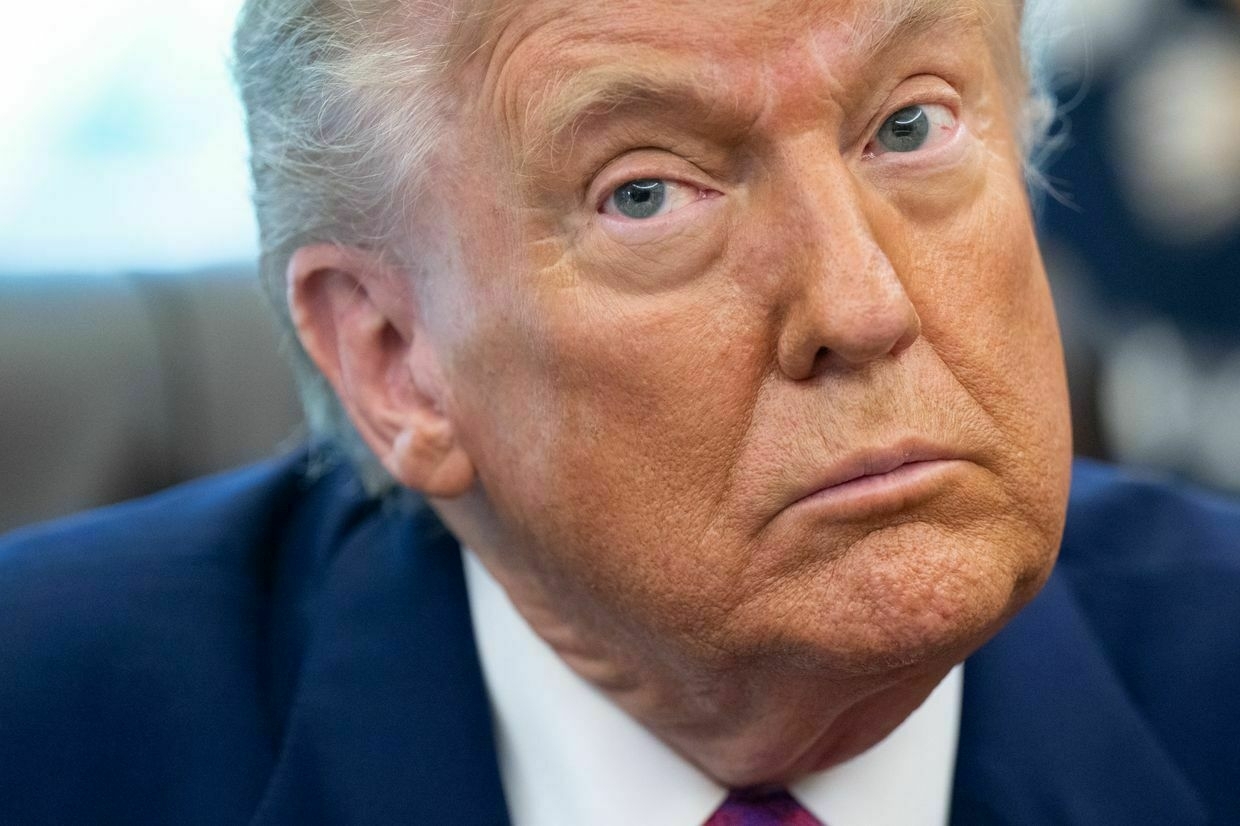
-
Ukraine arrests two suspects accused of extorting foreign defense supplier
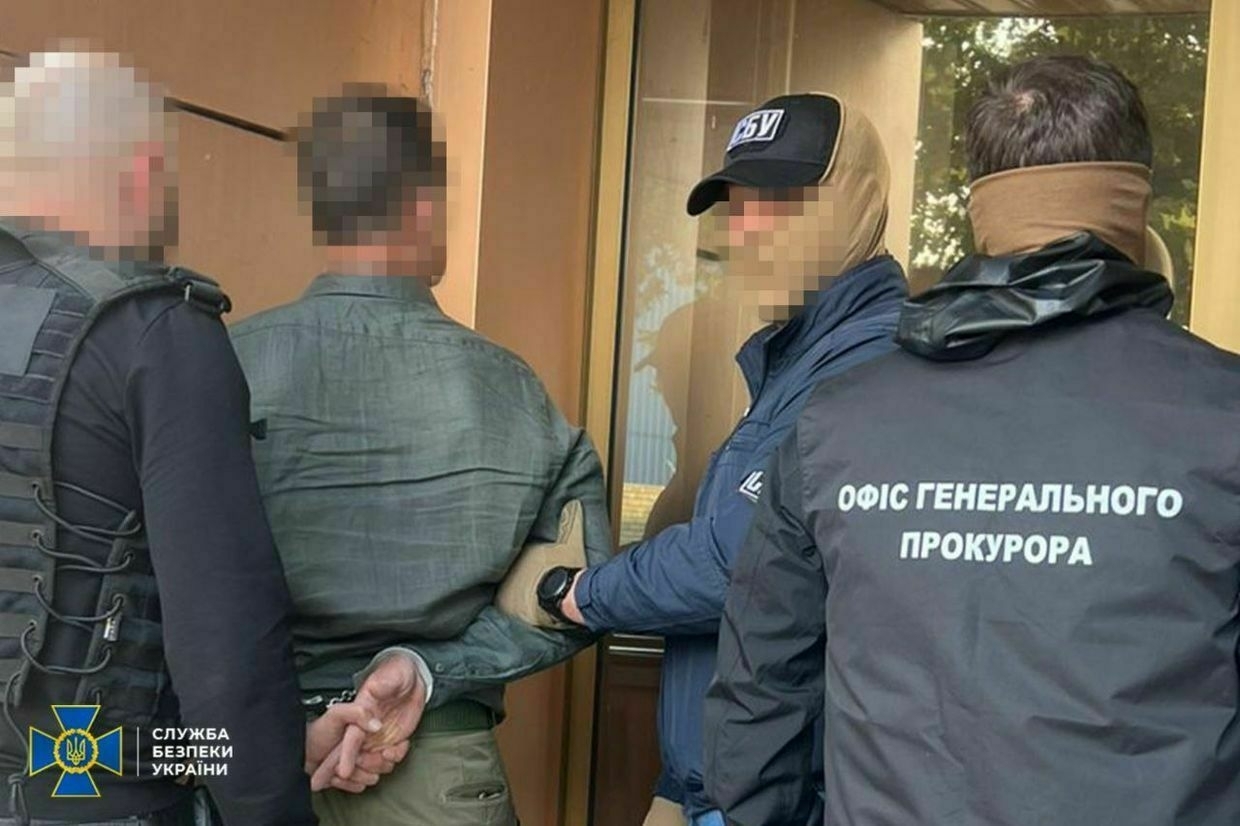
The Security Service of Ukraine (SBU) has arrested two individuals in Kyiv accused of attempting to extort $200,000 from a European defense company, potentially jeopardizing the delivery of electronic warfare (EW) systems to Ukraine’s military, the SBU reported on June 14.
The suspects allegedly demanded the payment in exchange for facilitating the successful testing and adoption of five radio electronic warfare systems provided to Ukraine at no cost, according to statements released by the SBU and the Prosecutor General’s Office.
The devices, supplied by a private foreign manufacturer, were financed by Ukraine’s international partners. The producer had already delivered five systems to Ukraine, with additional contracts possible if the equipment performed well in combat conditions, the SBU said.
According to investigators, the suspects falsely claimed to have influence within Ukraine’s Defense Ministry and promised to use their connections to ensure positive evaluations of the equipment.
“Under the guise of having contacts within the ministry, the men demanded $200,000 from the company in exchange for ensuring no obstacles during official trials of the equipment,” the Prosecutor General’s Office said in a statement.
Both men have been formally charged under Ukraine’s Criminal Code for alleged obstruction of the Armed Forces and receiving unlawful benefits through influence peddling. The charges carry a possible sentence of up to eight years in prison and asset confiscation.
The arrests were made as part of a broader investigation led by the SBU and conducted under the procedural oversight of the Specialized Defense Prosecutor’s Office. Authorities say the investigation is ongoing to identify all individuals involved.
Ukraine continues to rely heavily on international military assistance as it defends against Russia’s full-scale invasion, now in its fourth year. Ukraine uses EW systems during Russian attacks on its cities and on the front line.
Kyiv and its Western partners launched an electronic warfare coalition in April, which consists of 11 countries and comes on top of other eight Western coalitions to support Ukraine. Other similar initiatives include an artillery coalition, a fighter jet coalition, and a demining coalition, organized within the framework of the Ramstein format.
From buffer zone to new front: Russia pushes deeper into Sumy OblastIn March 2025, as Ukrainian forces made their final retreat from Sudzha in Russia’s Kursk Oblast, new grey spots began to appear on open-source maps on the other side of the state border, in Ukraine’s Sumy Oblast. For the first time since 2022, when Moscow’s forces retreatedThe Kyiv IndependentFrancis Farrell
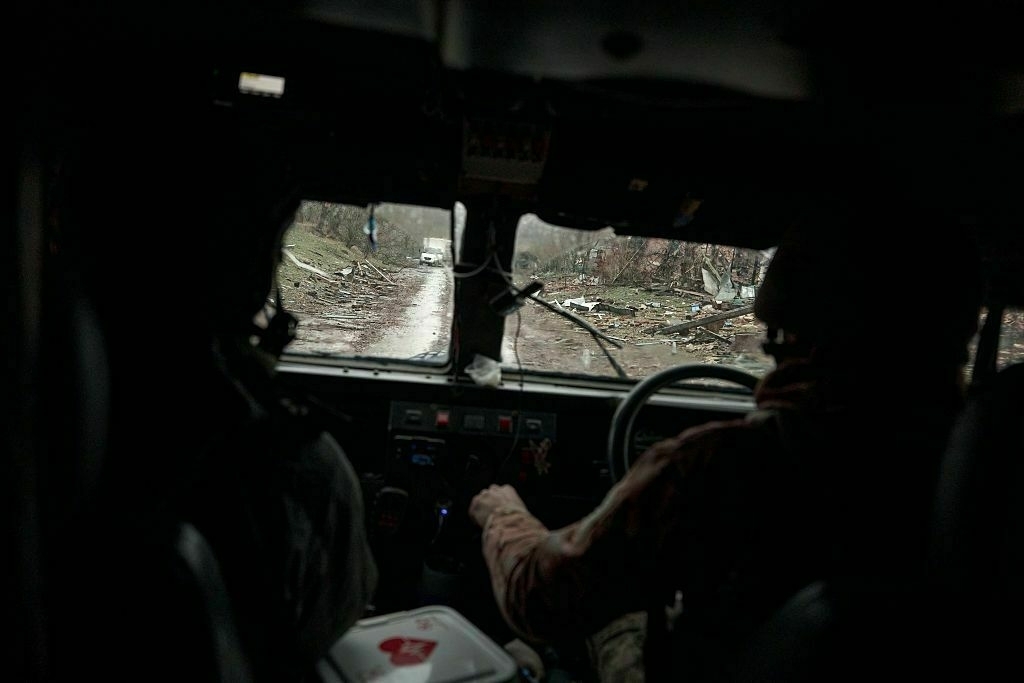
-
Ukraine breathes new life into Soviet-era missile systems: Buk and S-300 upgrades in the works
Ukraine is taking significant steps to upgrade its Soviet-era military technology, notably the "Buk" surface-to-air missile system. According to Brigadier General Anatoliy Klochkо, Deputy Defense Minister, the "Buk" now boasts enhanced capabilities with new missiles and is already engaged in active operations. In a recent interview) on the Ministry of Defense's YouTube channel, Klochko revealed that updates for the S-300 missile system are next in line. He teased that although changes are underway, the public can expect concrete results only in the second half of 2025, as the process is currently "on paper.”
The Deputy Minister also highlighted advances in ballistic technology, promising more detailed updates soon. As of now, the Ukrainian defense industry's modernization efforts are meeting about a third of the military's demands, particularly with Soviet-era air defense systems.
Previously, reports hinted at efforts to retrofit the Buk-M1 to accommodate American RIM-7 Sea Sparrow and AIM-9 missiles. Additionally, Ukraine’s FrankenSAM project attempts to adapt the 60 launch vehicles of the "Buk-M1," which are presently missile-less, for use with U.S. technology. Regarding the S-300 updates, one primary goal includes extending missile range and enhancing other features.
In May 2025, the Ukrainian Sapsan ballistic missiles successfully underwent combat testing, prompting the Defense Ministry to commence industrial production. According to analyst Valentyn Badrak, the Sapsan missiles outperform the ATACMS systems.
On June 12, Ukraine's Minister of Digital Transformation, Mykhailo Fedorov, unveiled a new Ukrainian drone named Bulava. He proudly announced that this device is already taking out Russian targets, surpassing the Russian Lancet drone in key metrics.
-
Nine Ukrainian students hospitalized after deadly bus crash in France
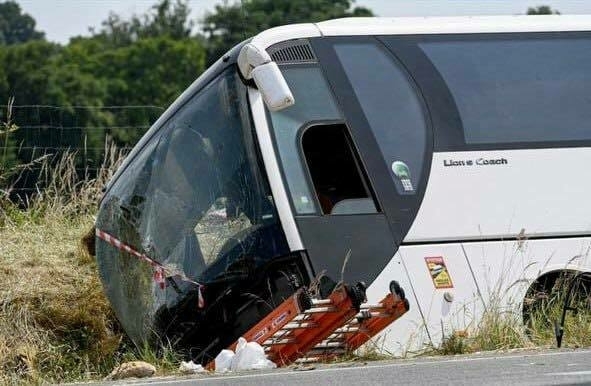
Nine Ukrainian students remain hospitalized following a deadly bus accident in France that killed three Ukrainian nationals and injured dozens more, Ukrainian officials confirmed on June 14.
The group, made up of students and teachers from Chernivtsi Oblast, was returning from an academic exchange when their bus veered off the road in the Sarthe department of France on June 13.
While en route to Paris, the bus veered off the road for reasons still under investigation and flipped into a ditch. In addition to the four fatalities, French media reported nine people were seriously injured and 18 sustained minor injuries.
According to Ruslan Zaparaniuk, governor of Chernivtsi Oblast, nine Ukrainian students remain hospitalized, though their conditions are stable. “All other people have received the necessary support, food, and temporary shelter and are now in safe locations,” he wrote on Facebook.
Zaparaniuk noted that Ukraine’s Embassy in France is organizing the logistics to help the children return home and is assisting parents wishing to travel to France to visit their hospitalized children.
Ukraine’s Embassy in France said that a diplomatic team, led by Ambassador Vadym Omelchenko, traveled to the crash site and remains in Sarthe to support victims and coordinate with French authorities.
According to the embassy, two people injured in the crash remain in critical condition. All other victims are receiving medical treatment and support from Ukrainian and French teams.
President Volodymyr Zelensky expressed condolences in a June 13 statement, calling the accident “terrible news” and thanking French authorities for their solidarity and rapid response.
Three Ukrainians killed in bus accident in France, Zelensky confirmsThree Ukrainian nationals were killed in a bus accident in France on June 13, President Volodymyr Zelensky confirmed in a statement on Telegram. The accident occurred in northwestern France as a group of Ukrainian adults and children was returning from an educational exchange.The Kyiv IndependentLucy Pakhnyuk
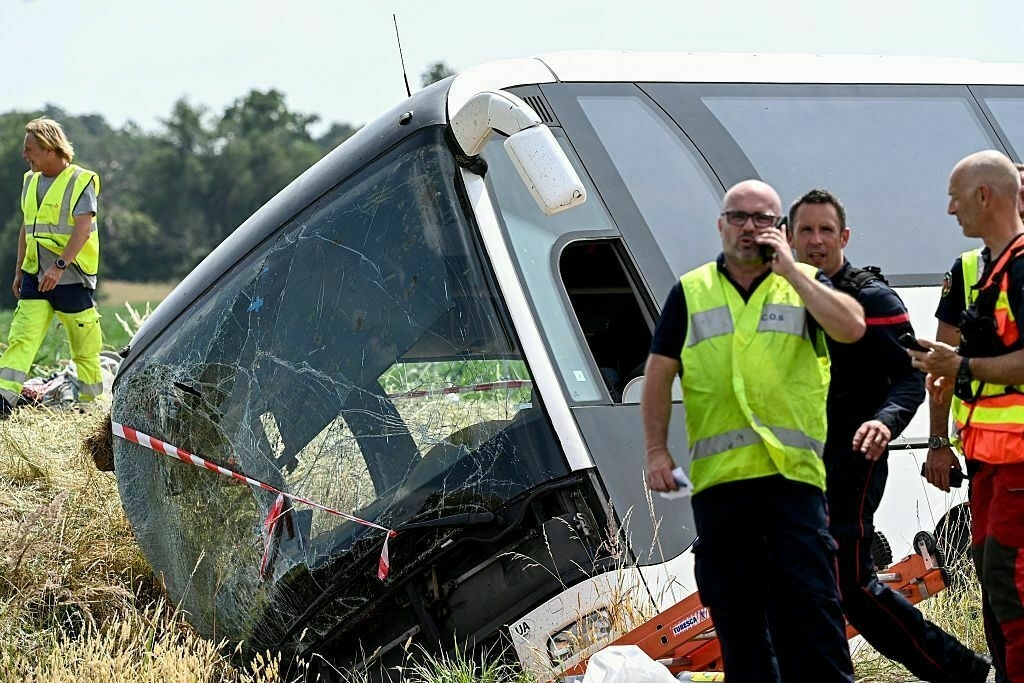
-
From buffer zone to new front: Russia pushes deeper into Sumy Oblast
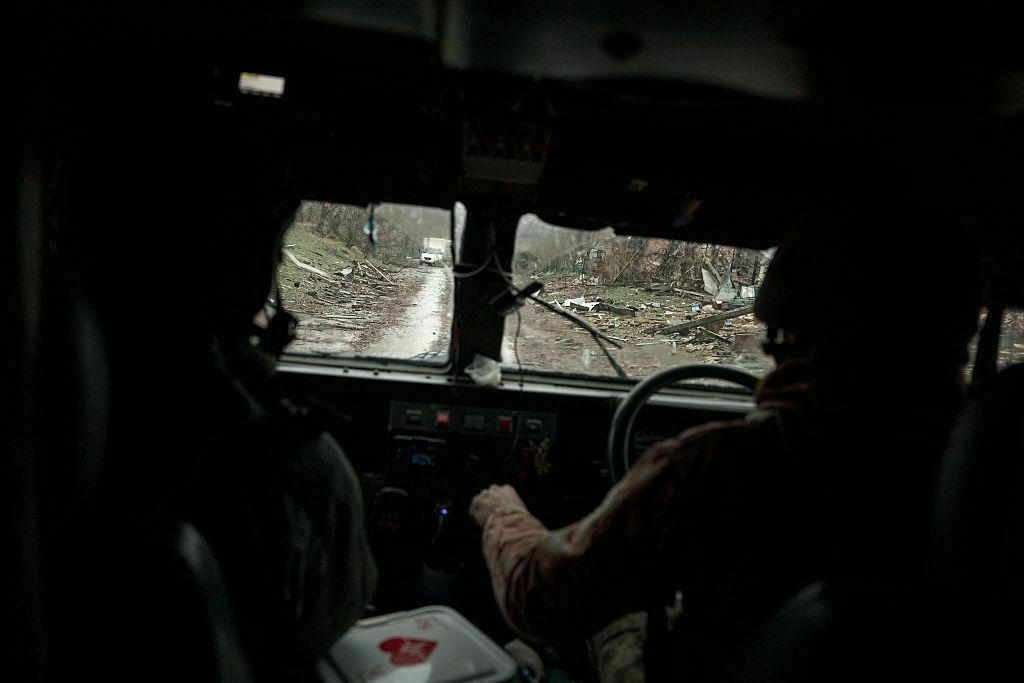
In March 2025, as Ukrainian forces made their final retreat from Sudzha in Russia’s Kursk Oblast, new grey spots began to appear on open-source maps on the other side of the state border, in Ukraine’s Sumy Oblast.
For the first time since 2022, when Moscow’s forces retreated frantically from northern Ukraine, Russian troops have once again set their sights on Sumy Oblast.
But for months, as Kyiv continued to claim hold of a thin sliver of Kursk Oblast and Russia’s spring offensive escalated in eastern Ukraine, the fighting around the border in Sumy Oblast was often overlooked.
Over June, Russian gains in Sumy Oblast have sped up significantly, taking several villages and coming within 20 kilometers of the regional capital of Sumy, according to territorial changes reported by open-source mapping project DeepState.
As of June 12, fighting has been reported to have begun for the village of Yunakivka, a key stop on the cross-border highway between Sudzha and Sumy and a staging point for Ukraine’s incursion into Kursk Oblast.
Over spring and summer, this part of the front line has been subject to strict restrictions on media access, with journalists barred from working with the military north of Sumy.
On June 12, President Volodymyr Zelensky said that Ukrainian forces had managed to “push the enemy back” in some parts of Sumy Oblast, but these territorial changes are so far impossible to verify.
Speaking to journalists on June 13, Zelensky said that the Russian advance on Sumy Oblast “had been stopped” no deeper than seven kilometers inside the Ukrainian border, adding that some ground had been regained around the village of Andriivka.
Murky intentionsWith Russia now holding over 200 square kilometers in Sumy Oblast, similar to that seized in the cross-border offensive on Kharkiv Oblast in May 2024, evaluations of the operation are torn between it being a limited escalation of fighting in the border zone or a major new Russian push.
Not long after launching the Kursk incursion last summer, Kyiv claimed that part of the offensive’s aim was to create a “buffer zone” to protect Sumy Oblast, although in reality, the spike in Ukrainian military activity saw increased Russian strikes on border settlements where Ukrainian troops and equipment were based.
After returning from a visit to Kursk Oblast in May, Russian President Vladimir Putin announced the creation of a “security buffer zone” of his own along Ukraine’s northern state border.
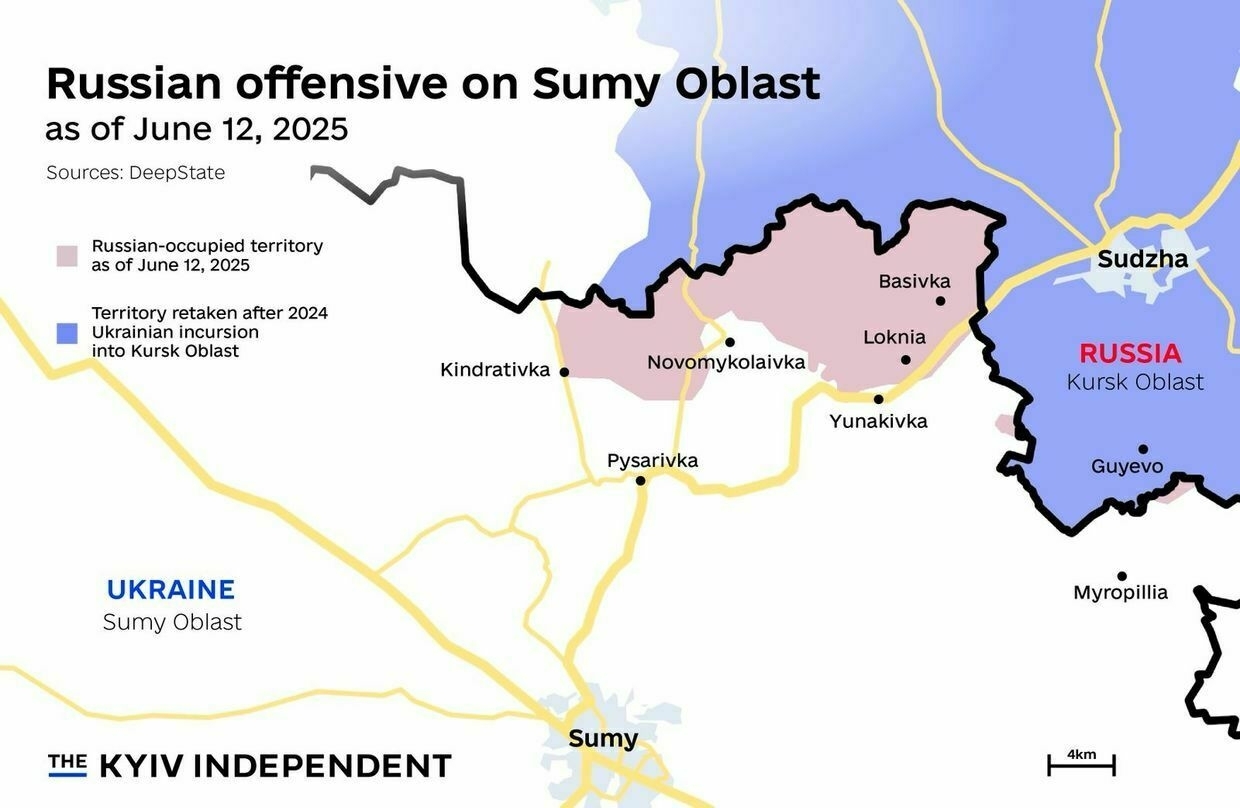
Map shows Russia’s advance into northern Ukrainian Sumy Oblast as part of its ongoing spring-summer 2025 offensive. The sentiment was repeated on June 11 by Alexei Zhuravlev, first deputy head of the Russian State Duma’s defense committee, adding that Russia was not looking to take all of Sumy Oblast (which is not one of the five regions illegally claimed by Moscow).
“A buffer zone of one hundred kilometers along the Russian border will be enough,” Zhuravlev said. “Let them evacuate, retreat in fear, waiting everywhere for the attack of the Russian army.”
Even if Moscow wanted to, mounting a direct assault on a large city like Sumy – with a pre-war population of 255,000 – would almost certainly be out of the reach of Russia’s capabilities for the moment, said analyst Emil Kastehelmi, a member of the Finland-based open-source intelligence collective Black Bird Group.
“The Russians haven’t been able to actually capture any larger cities in Ukraine since 2022 (with the surrounding and capture of Mariupol in Donetsk Oblast),” he said.
“What they can do is put heavy pressure on the Sumy direction and try to gain as much land as possible, in order to bring Sumy into range of artillery and drones, tying Ukrainian troops into defensive battles and giving Russia some leverage in upcoming negotiations.”
Unrelenting pressureRussia’s push in Sumy Oblast comes amid a broader spring-summer offensive that has also seen significant gains in Donetsk Oblast, especially on either flank of the embattled city of Pokrovsk.
With the Ukrainian army significantly overstretched along hundreds of kilometers of front line and suffering from chronic manpower shortages, especially in the infantry, Russia’s pressure on Sumy Oblast creates more dilemmas.
“The Russians are most likely trying to create as many issues for the Ukrainians as possible in several directions simultaneously,” Kastehelmi said.
“They aim to create a cascading situation where the Ukrainians need to answer to a crisis in a certain sector by throwing in units from another place, resulting in units not being able to do proper rotations.”
Still, with Russian forces relying on the same formula of creeping, infantry-based assaults employed all across a drone-saturated front line, maintaining pressure also comes with sacrifices made in offensive potential elsewhere.
Join our communitySupport independent journalism in Ukraine. Join us in this fight.Support usSpeaking to the Kyiv Independent, Volodymyr Martyniak, a company commander in the 22nd Special Purpose Battalion of Ukraine’s 1st Presidential Brigade, said that Russia’s main advantage in Sumy Oblast remained their ability to send wave after wave of lightly-mounted infantry at the Ukrainian defense.
“They are being organized into ultra-minimal teams, of just a couple of people, using the bare minimum of equipment,” he said,” things like quad bikes, other motorized vehicles, motorcycles to move quickly through rough terrain.”
According to Martyniak, Russian forces in the area use a mix of expendable, cannon-fodder style infantry troops in the first waves of an attack, which are then followed by more experienced soldiers, demonstrating tactics refined since the Battle of Bakhmut over two years ago.
“At first, soldiers go in simply to move forward and dig in,” he described.
“Then, once enough of them have gathered in a certain area, enough to justify bringing in something more serious, a more advanced, better-trained, and correspondingly more professional unit follows.”‘Find and destroy’ – how Ukraine’s own Peaky Blinders mastered the art of bomber dronesEditor’s note: In accordance with the security protocols of the Ukrainian military, soldiers featured in this story are identified by first names and callsigns only. DONETSK OBLAST – From the moment the vehicles duck into pre-prepared positions in the leafy treeline to the first dead Russian soldiers, less than twentyThe Kyiv IndependentFrancis Farrell
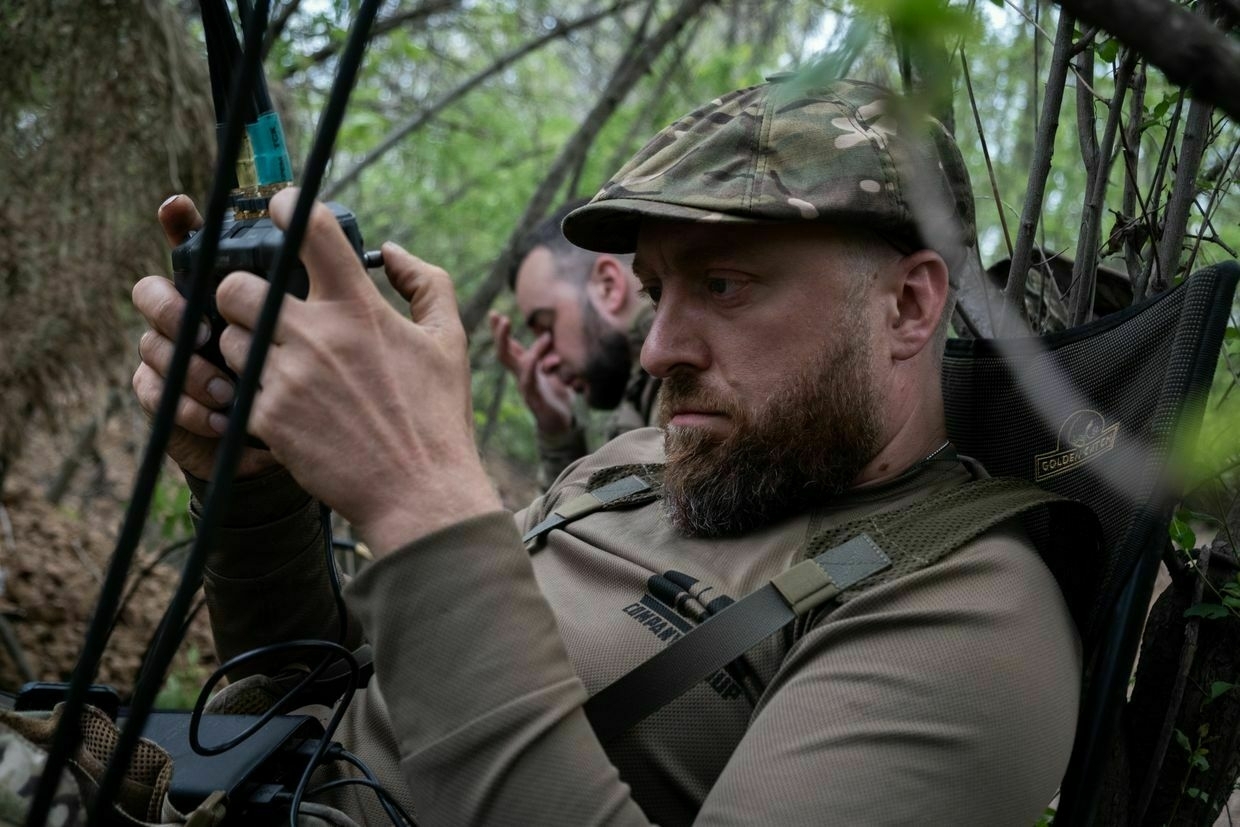
Faltering fortificationsJust as when Russian troops broke across the border toward Kharkiv last May, the current advance in Sumy has raised concerns among the military and society about the preparedness of Ukrainian fortifications along the state border.
As per the Defense Ministry’s fortification-building initiative laid out in late 2023 and executed over 2024, while Ukrainian brigades and combat engineers would build the two lines of defense closest to the enemy, the third and strongest line of defense would be built by civilian contractors coordinated and paid for by regional administrations.
Rather than coherent lines of defense, these fortifications were built around platoon strongpoints — individual fortresses consisting of several reinforced concrete bunkers connected by trenches.
But as in Kharkiv and Donetsk oblasts, these fortifications have been criticized as poorly designed and built. Trenches and platoon strongpoints planned in 2024 were often constructed in open fields, with little regard for concealment or protection from drones.
One Ukrainian combat medic, who requested to remain anonymous for security reasons, said that compared to areas in Donetsk Oblast where fortifications had been built in advance even if not ideally, nothing of the like could be seen in Sumy Oblast.
Although defending Ukrainian territory was easier than holding positions across the border because of better logistics routes, he said, there were still little to no prepared lines of defense waiting for them after the withdrawal.
Ukrainian defense lines between the village of Pysarivka in Ukraine and Sudzha in Russia s Kursk Oblast on March 16, 2025. (Photo by Philippe de Poulpiquet / Hans Lucas / Hans Lucas/AFP via Getty Images) 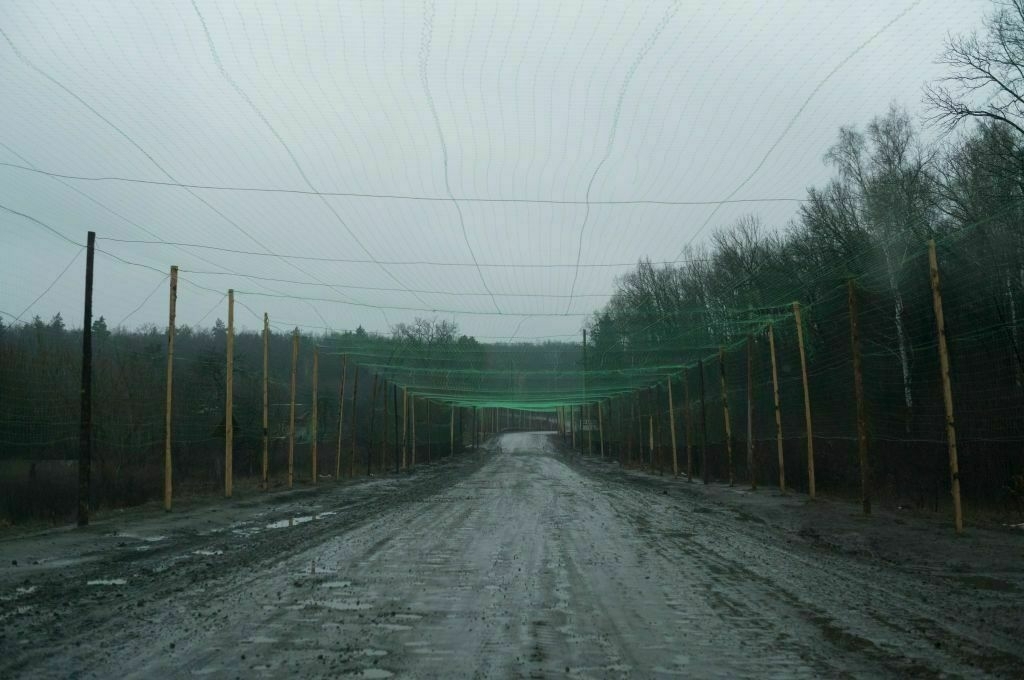
The Ukrainian army has installed a 10km-long protective net on a road to protect civilian and military vehicles from kamikaze drones sent by the Russian army between the village of Pysarivka in Ukraine and Sudzha in Russia s Kursk Oblast on March 16, 2025. (Photo by Philippe de Poulpiquet / Hans Lucas / Hans Lucas/ AFP via Getty Images) Ultimately, the strength of any line of defense is dependent not only on the fortifications themselves, but on the ability of the defending side to man them with enough combat effective infantry.
Excess losses among Ukrainian units holding Kursk Oblast, where Ukrainian commanders had reported politically-motivated orders to hold Russian territory despite logistics routes being controlled by Russian drones, have made it easier for Russian forces to continue their advance across the border.
In these conditions, Martyniak — whose battalion fought inside Kursk Oblast before crossing the border — says the defense of territory inside Ukraine started straight after the withdrawal from Sudzha in March.
According to the commander, Ukraine’s main problem in defense consistently remains the lack of manpower in the infantry.
Efforts have been made to improve training and focus more on replenishing existing brigades rather than creating new ones, but by 2025, almost all new Ukrainian infantrymen are mobilized rather than volunteer soldiers.
Meanwhile, as the skies above the front line become more saturated with enemy drones with each passing month, the experience of the foot soldier only gets deadlier and more difficult.“Replenishments come in, but they must be trained, they must be professional, and, let’s say, they must have some kind of motivation,” Martyniak said.
As Russia inches closer to Dnipropetrovsk Oblast, new Ukrainian region might soon be at warMoscow said its troops had crossed into Dnipropetrovsk Oblast and were conducting offensive operations in the region, a claim Kyiv quickly denied as “Russian disinformation.” Russian troops have been pushing toward Dnipropetrovsk Oblast for months, trying to solidify the southern flank to capture Pokrovsk and the remaining parts of theThe Kyiv IndependentAsami Terajima
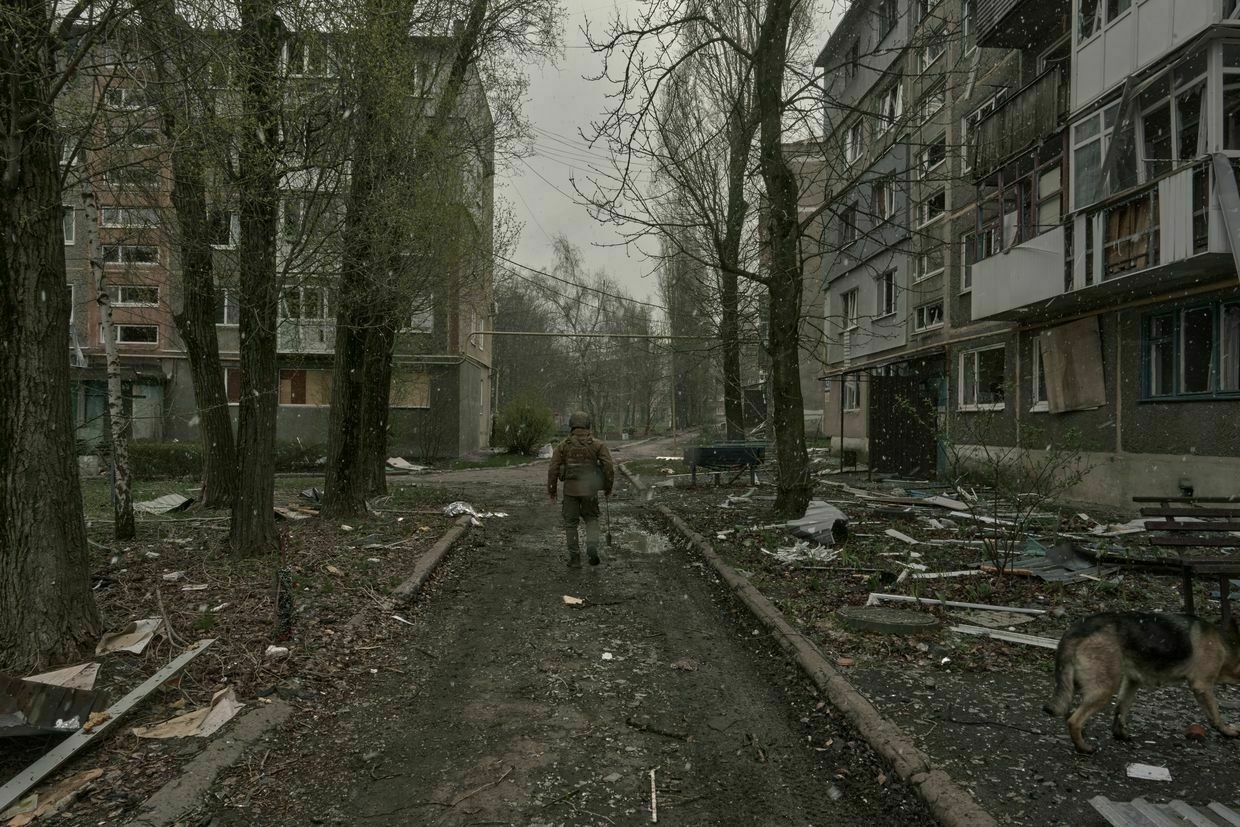
New threatsFurther Russian gains toward Sumy could gradually bring the city into range of enemy first-person view (FPV) drones, which Russian forces often use not only to cut off enemy logistics, but to make entire cities unlivable by targeting civilian vehicles, as has been done with Kherson in the south.
With Russian forces constantly improving the range of their FPV drones, including those running on unjammable fiber optic connections, the first such drones could fly into Sumy sooner rather than later.
Recent strikes increasingly deep behind Ukrainian lines in Donetsk Oblast including on the cities of Sloviansk and Druzhkivka have shown how FPV drones can fly further and further into the Ukrainian rear even if the front line itself doesn’t move much.Over 2025, amid Sumy’s increasing proximity to the front line and continued intense fighting along the border has seen the city subject to strikes from other weapons, including a missile strike in April that killed 35 people and wounded 129.
On June 4, Russia struck Sumy with multiple-launch rocket systems, killing four and wounding 28, in the first attack with this kind of weapon recorded on the city since it was almost surrounded by Russian forces at the onset of the full-scale invasion in 2022.
As the summer campaign in Ukraine heats up, Sumy Oblast threatens to become a new regular hotspot along the front line, whether or not Russian forces can keep up their pace of attack.
“Their real advantage here is that they have a massive military resource, first and foremost — a very large one,” said Martyniak, “the enemy, as always, is building up its forces; they don’t stand still, things are always in motion on their side, and they’re constantly coming up with something new.”
“We, for our part, also try to respond with the same skills, the same experience, the same capability; we are carrying out our missions and holding the line with dignity.”
Note from the author:
Hi, this is Francis Farrell, and thank you for reading this article. When thinking about a major new front opening in Sumy Oblast, I can only hope that Zelensky is right when he says that Russia's advance has been stopped, and that just like with Kharkiv Oblast last year, the lines will stabilize and no more red will appear on the map in the area. Hope is nice, but whatever happens Russia only stops if they are stopped, and that comes at a price. For that reason, we will not stop what we are doing for a minute. Please consider supporting our reporting.
-
Zelensky: Russians halted in Sumy region
During a press briefing, Ukrainian President Volodymyr Zelensky rejected claims of Russian troop "advancements" in the Dnipropetrovsk region. According to him, heavy fighting continues on the Sumy front along the border, where Russian forces have been stopped.
"The North-Slobodsky area, which we call the Sumy direction, is a key focus. Our position is holding steady. Crucially, there are 53,000 Russians there. The battles rage along the border, and the enemy has been stopped. The maximum battle depth from the border is 7 km, showing how far the city of Sumy is," he stated. Zelensky highlighted hot spots like Andriivka, Kondrativka, Oleksiivka, and Kostiantynivka. It's worth noting there's another Kostiantynivka in the East direction. "We regained control over Andriivka today," he added. Additionally, threats in the Luhansk direction have been neutralized, and intense fighting is ongoing near Kostiantynivka. While Russians had an edge, the Ukrainian Defense Forces are now advancing along the highway. No enemy advancement in Dnipropetrovsk region today, he confirmed. Zelensky dismissed Russian "advancements" in Dnipropetrovsk region.
"There's no advancement into Dnipropetrovsk region for now. Yet they are keen on an information campaign... trying to set foot up to the administrative boundary. They aim to capture a photo or video, hence deploying tiny sabotage groups," Zelensky elaborated.
On Friday, Ukrainian forces reportedly eliminated one such enemy group consisting of six Russians just a kilometer from the administrative border. "They managed to sneak because they're a small group and remained undetected. Dense vegetation conceals them, so they're skirting through the groves," he said. Earlier, Sumy region expanded the mandatory evacuation zone. In total, 213 settlements are under mandatory evacuation orders. According to the DeepState project, Russian forces have advanced to 20 kilometers from Sumy, which may soon lead to FPV drone strikes on the regional center.
-
Ukrainian drones target key Russian industrial sites in Samara and Stavropol regions
Two major industrial sites involved in the production of explosives and ammunition in Russia were hit by Ukrainan drones, reported the Ukrainian Armed Forces' General Staff on June 14.
In the early hours of Saturday, June 14, drones struck the "Nevinnomyssk Azot" chemical plant in the Stavropol region and the Novokuibyshevsk Catalysts Plant in the Samara region. "Nevinnomyssk Azot," part of the EuroChem group, stands as Russia's largest producer of ammonia and nitrogen fertilizers.
Operations were reportedly carried out by Unmanned Systems Forces, in coordination with other Defense Forces components.
"Facilities at JSC NNK in Russia's Samara region have been compromised. This is a leading enterprise in the production of explosive components, categorized as a defense industry facility in Russia. Explosions and a fire occurred within the industrial area," stated the General Staff.
Earlier on Saturday, drones targeted the Nevinnomyssk Nitrogen Plant in Russia's Stavropol region, where ammonia and ammonium nitrate, essential for explosives and artillery shells, are produced.
"The plant plays a major role in supporting Russia's armed aggression against Ukraine. Reports indicate a series of explosions and enemy anti-aircraft defense activities at the target's vicinity, with a fire recorded in the industrial zone. The effects of the strike are being clarified," the General Staff added.
The facility has the capacity to produce approximately 1 million tons of ammonia, 1.4 million tons of ammonium nitrate, and 0.89 million tons of urea annually.
Local residents shared videos on social media capturing fires that broke out after the drone strike—this contradicts major Russian media reports that the UAV attack was thwarted.
-
Fourth exchange in a week! Ukrainian defenders return home #shorts
-
The ‘Red Beaches’ of a Taiwan invasion
Editor’s Note:
Editor’s note: June has historically been our toughest month, where we see a lot of unsubscribes.
Amid the constant attacks in Ukraine, we need your help: will you upgrade to a paid subscription to support our original work now?
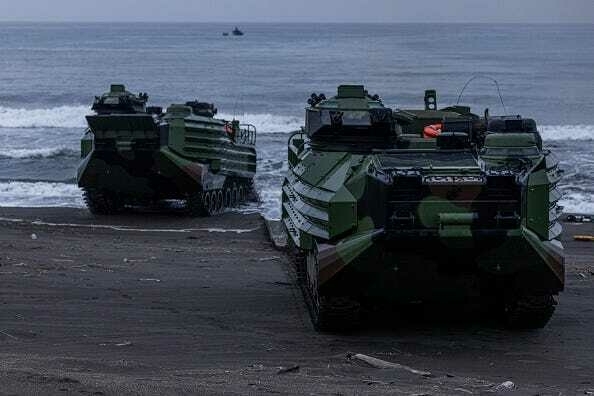
The Taiwanese military conducts amphibious landings to simulate People's Liberation Army (PLA) forces landing on three beaches in Yilan County. These beaches are identified by experts as "red beaches" which are vulnerable to a potential invasion by China. (Photo by Annabelle Chih/Getty Images). Li Ming Zhong has been interested in Taiwanese nature since he was a little boy, when he ran next to the Tamsui River in Taipei and into a nearby forest, where he would sit for hours to observe the natural world.
His passion for nature inspired him to take several solo trips to remote landscapes, eventually leading him to become a high school geography teacher in Taipei.
Ming Zhong, 43, who goes by Willie in school to make it easier for his students to remember his name, has been a teacher for 21 years.
Yet, never did he think he would one day be analyzing Taiwan’s landscape for potential military landing sites as a Chinese invasion over the island looms.
“A ‘red beach’ is a place that is easy for [military landing craft] to land, and harder for [Taiwan] to defend,” Ming Zhong told The Counteroffensive.
Taiwan’s rugged terrain limits the number of viable locations for a Chinese military landing in the event of an invasion. However, there are between a dozen and 20 designated ‘red beaches’ across the island that are considered suitable for such operations.
Over the past decade, Taiwan’s defense ministry has been actively preparing its forces, conducting regular military drills to ensure they can respond swiftly and defend against potential simultaneous attacks by the Chinese military.
We were allowed to tag along for some of these drills.
Military personnel participate an amphibious landing drill on May 24, 2023 in Yilan, Taiwan. (Photo by Annabelle Chih/Getty Images). Red beaches are characterized by being sandy beaches as opposed to ones with many rocks, Ming Zhong said, which makes it easier for the Chinese army to land on.
Most of these can be found on the West Coast, which is closer to mainland China, thereby reducing the time during which Chinese troops would be vulnerable during the passage across the Taiwan Strait.
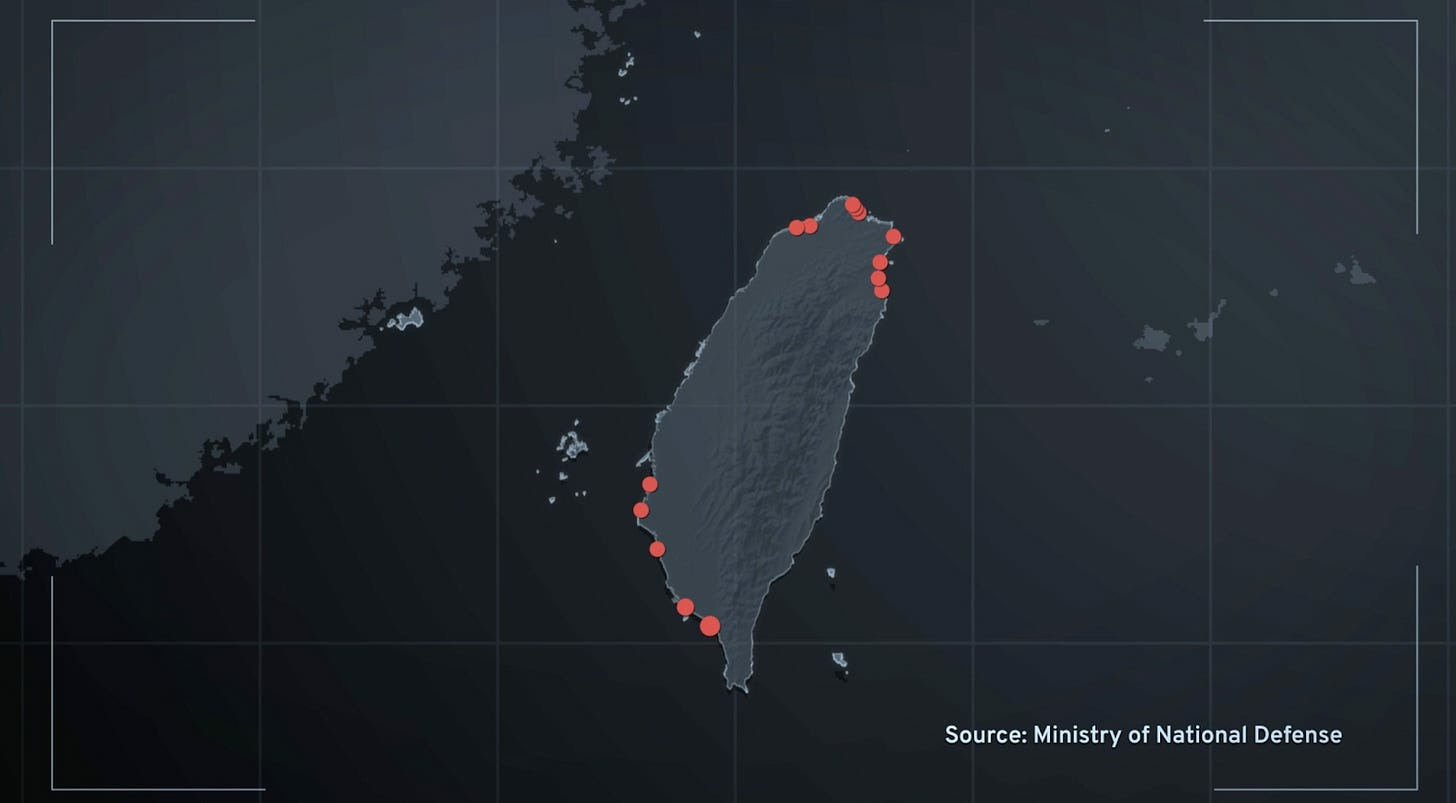
Some of Taiwan’s ‘Red Beaches,’ as identified by its government. Source: Ministry of National Defense via Taiwan Plus News. What many are not aware of, Ming Zhong said, is that Taiwan has natural defenses that will help the island in the wake of an invasion.
The fact that the Taiwan Strait divides the island from the People’s Republic of China (PRC) is an advantage because it gives Taipei time to respond, according to Ming Zhong. The Taiwan Strait is approximately 160 km wide at its narrowest point, and each crossing by a Chinese landing craft would take several hours.
The tide is also a natural advantage of the island, Ming Zhong said. The low tide around the West Coast city of Taichung prohibits big enemy ships from accessing the island, he added.
In addition, the capital city of Taipei is surrounded by mountains, which means that military tanks landing on the red beaches would have to cross them to reach the capital.
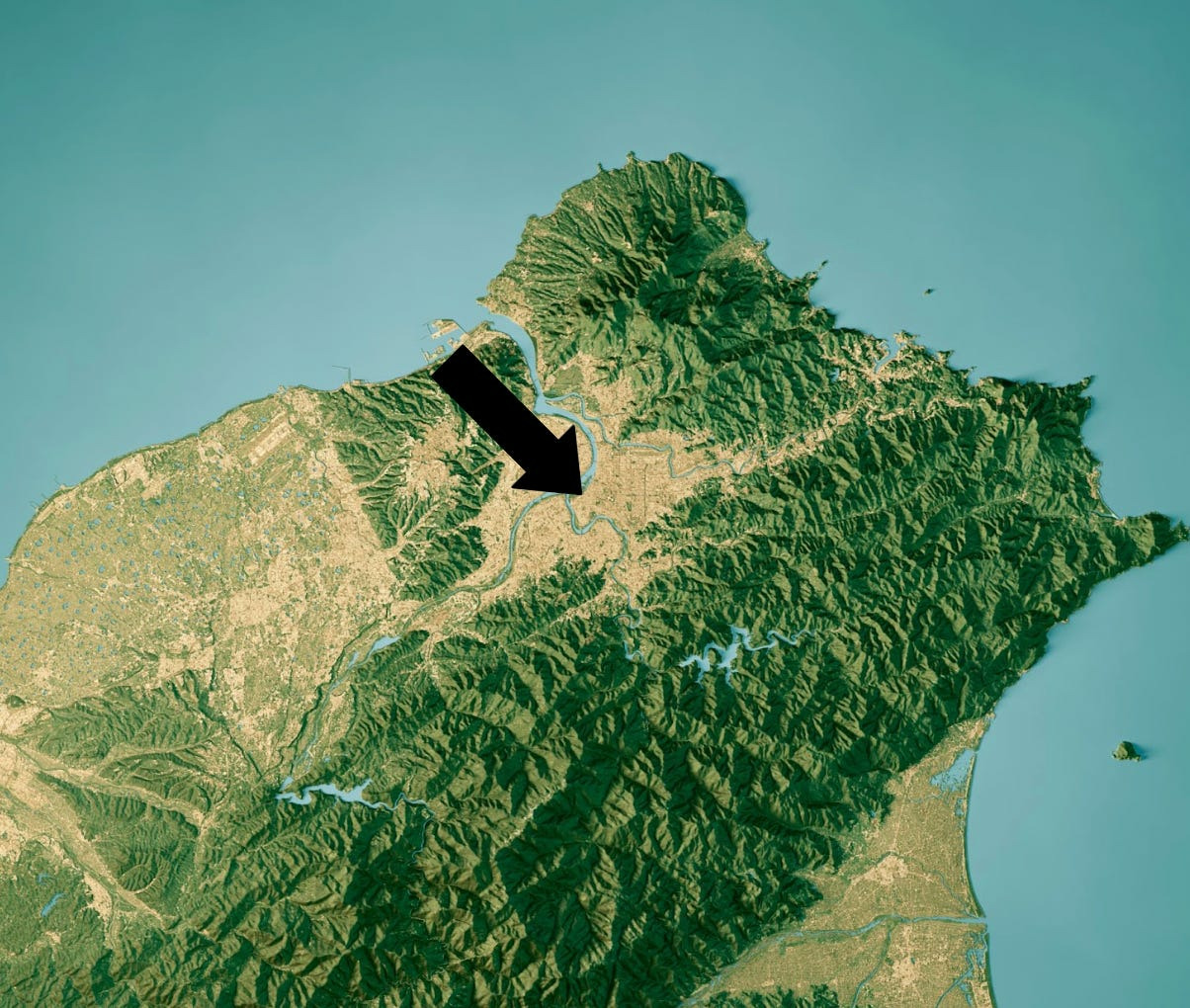
3D Render of a Topographic Map of Taipei City, Taiwan. Arrow points to Taipei. (Photo Credit: Frank Ramspott/ Getty Images). The People’s Liberation Army, the military of the Chinese Communist Party, has been ramping up military pressure over Taiwan since 2016, when the Democratic Progressive Party returned to office in Taipei and refused to endorse Beijing’s ‘One China’ framework. Despite never having governed Taiwan, the PRC views the island as a breakaway province, with China’s President Xi Jinping stating that reunification between Taipei and Beijing is inevitable.
Living in Taiwan, and facing the CCP’s constant threat, Ming Zhong was defiant:
“We should never be afraid of China. History has shown us: Taiwan has been easy to protect and hard to attack… but we need to be aware of the danger, and train ourselves to be ready when bad things happen.”
Amidst a possible Chinese invasion, Taiwan has been intensifying its defense strategy over the past years. Taiwan's President Lai Ching-te announced a civil mobilization plan last year to recruit approximately 400,000 people, including active and former military personnel, as well as volunteers from the police and fire departments.
The Counteroffensive was able to observe a number of military exercises by the Taiwanese Air Force, Navy, Army, and Marines.
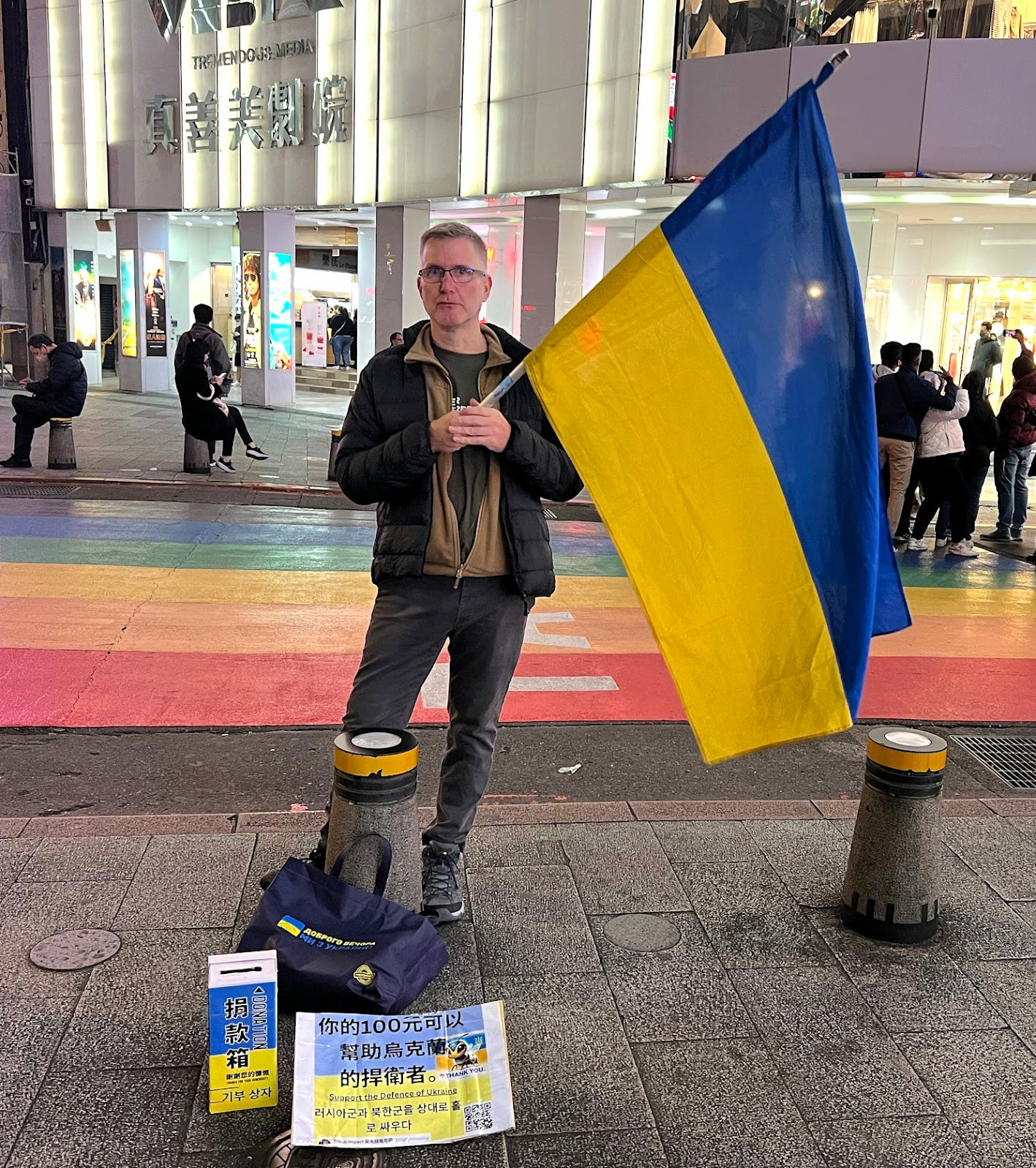
A protester in Taipei reminds the Taiwanese public of Russia’s invasion, raising money for the defense of Ukraine. The war in Ukraine has opened the eyes of people in Taiwan on the importance of asymmetric warfare, Wu Tzu-li, an associate research fellow with Taiwan's military think tank, the Institute for National Defense and Security Research, told The Counteroffensive.
Asymmetric warfare is a conflict characterized by a significant disparity in military capabilities and resources between the two sides, and where the weaker side uses unconventional methods to defeat its opponent.
The PRC’s military, which has about 2 million recruits, far surpasses Taiwan’s 215,000 force.
Ukraine has managed to stand out on the battlefield amid its use of drones, Wu said, which has inspired the Taiwanese government to assemble its local production of UAVs and to integrate them into its military strategy.
Before Russia’s invasion of Ukraine, Taiwan’s drone inventory was small, with only a few hundred units of four types of drones. Yet, in 2022, Taiwan’s government launched the ‘Drone National Team’ program to recruit the country’s commercial drone makers and aviation firms to create a self-sufficient drone industry.
Did you know we have a sister publication that covers defense technology right from the battlefield? Here’s our latest piece on Taiwanese military technology and what they’re learning from the war in Ukraine.
Shortly after Russia invaded Ukraine, Lieutenant Colonel Liu Yongcheng, of the 23rd Fighter Squadron, has been monitoring the situation in Ukraine and assessing the need for Taiwan to rapidly deploy its air assets.
At the moment, he does not think it is possible to replace manned aircraft, such as the F-16 fighter jets, with drones, he told The Counteroffensive. Yet, he sees drones playing a significant role in the future, especially when combined with large airframes.
Javelin anti-tank missiles have also helped Ukraine push Russian forces out of Kyiv in the early days of the invasion.
Sergeant Wang Zhi Han of the 9th Marine Corps in Taiwan told The Counteroffensive that they have been familiarizing themselves with Javelin missiles to target enemy vehicles in the event of an attack.
Taiwanese Marines drill on the use of Javelin anti-tank missiles.
Ukraine and Taiwan share many similarities in their fight against two superpowers that are trying to conquer them, Francois Wu, the Taiwanese Deputy Minister of Foreign Affairs, told The Counteroffensive.
But “the economic power of Taiwan is much more important than Ukraine,” he added, because Taiwan has the know-how of semiconductors, which is kind of indispensable for the modern world.”
Taiwan’s semiconductor industry has been acting as a ‘silicon shield’ for the island. The term refers to Taiwan’s ability to deter China’s threat: China might not want to invade Taiwan and disrupt the worldwide trade in semiconductors, which is critical for modern electronics.
Taiwan currently dominates the global semiconductor market, accounting for 68 percent of the world's semiconductor manufacturing, and the industry contributes nearly 15 percent of the island’s gross domestic product.
The PRC has invested billions in efforts to match Taiwan’s production and has set targets of achieving 40 percent self-sufficiency in chips by 2020 and 70 percent by 2025. Yet, it reportedly produces 16 percent of its needs and still imports over $400 billion worth of semiconductors.
While some believe this could be a motive for the PRC to invade Taiwan and maintain control of its semiconductor foundries, Beijing would be unable to achieve its goals if war left the infrastructure destroyed.
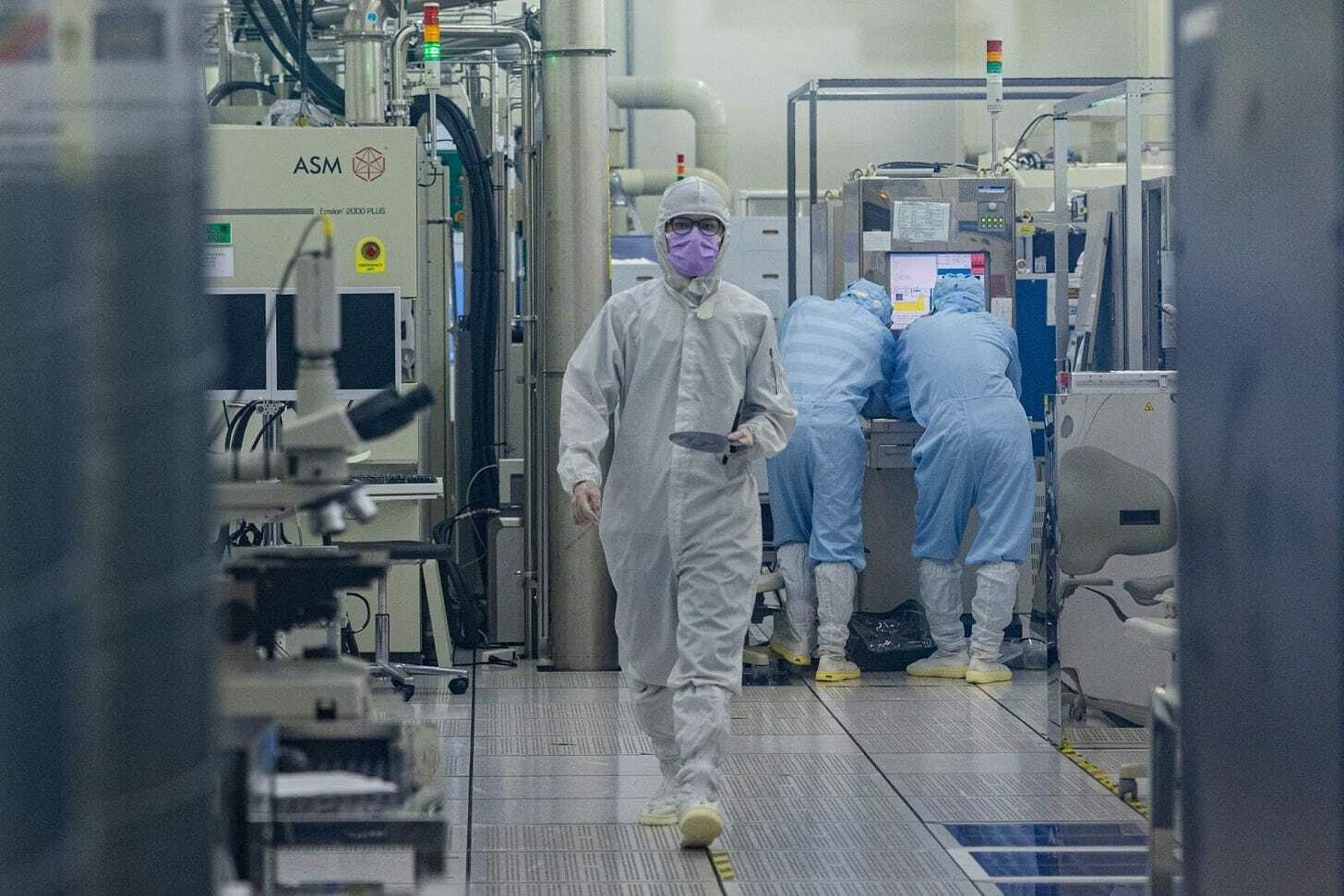
A student wears cleanroom suit conducts a research inside the clean room of Taiwan Semiconductor Research Institution during a press semiconductor tour at Hsinchu Science Park on September 16, 2022 in Hsinchu, Taiwan. (Photo Credit: Annabelle Chih/ Getty Images). “The problem is that now this know-how is not a simple factory,” Zhizhong said. “The semiconductor industry is an ecosystem,” and the result comes from a combination of “all the major democratic countries in the world,” he added.
In recent years, the PRC has intensified its military exercises in the Taiwan Strait, simulating land strikes, sea assaults, and blockades, further heightening tensions between Beijing and Taipei.
In April this year, the Chinese military launched strikes in the East China Sea and simulated blockades close to key shipping lanes near Taiwan. The PRC spent about 7 percent of its defense budget — about $15 billion — on exercises in the Western Pacific in 2023.
Some experts interpret the Chinese drills as rehearsals for a potential blockade aimed at toppling the government in Taipei.
It is easy to quarantine the island, according to Ming Zhong, the high school geography teacher. Yet, the Chinese military “is not used to fighting in the water,” so they will struggle to remain in position for long if they are unable to act fast, he added.
In addition, amid the stream in the Taiwan Strait, one of the island’s biggest natural defenses, the summer months are the hardest to cross as the boats would be going against the direction of the stream, which would require more power, Ming Zhong said.
The winter months, December until March, are easier due to the stream, he added.
The Chinese would also have to take into account Taiwan’s rainy season, which runs from May to June, and typhoon months, which span from July until October.
The easiest months for Beijing to invade would be April and November, according to Ming Zhong.
There are already drones on some of Taiwan’s red beaches. But they are for civilian purposes: fishermen use them to carry their lines deep out into the strait, for a better chance of catching their harvest.
Xing Li, a retired civil engineer who fishes in his spare time, told The Counteroffensive at Zhuwei Beach that he thinks the space was designated a red beach amid its calm and flat waters, particularly from May to August.
Other designated red beaches in Taiwan include Linkou, Jinshan, Zhuangwei, Luodong, Fulong, and Linyuan.
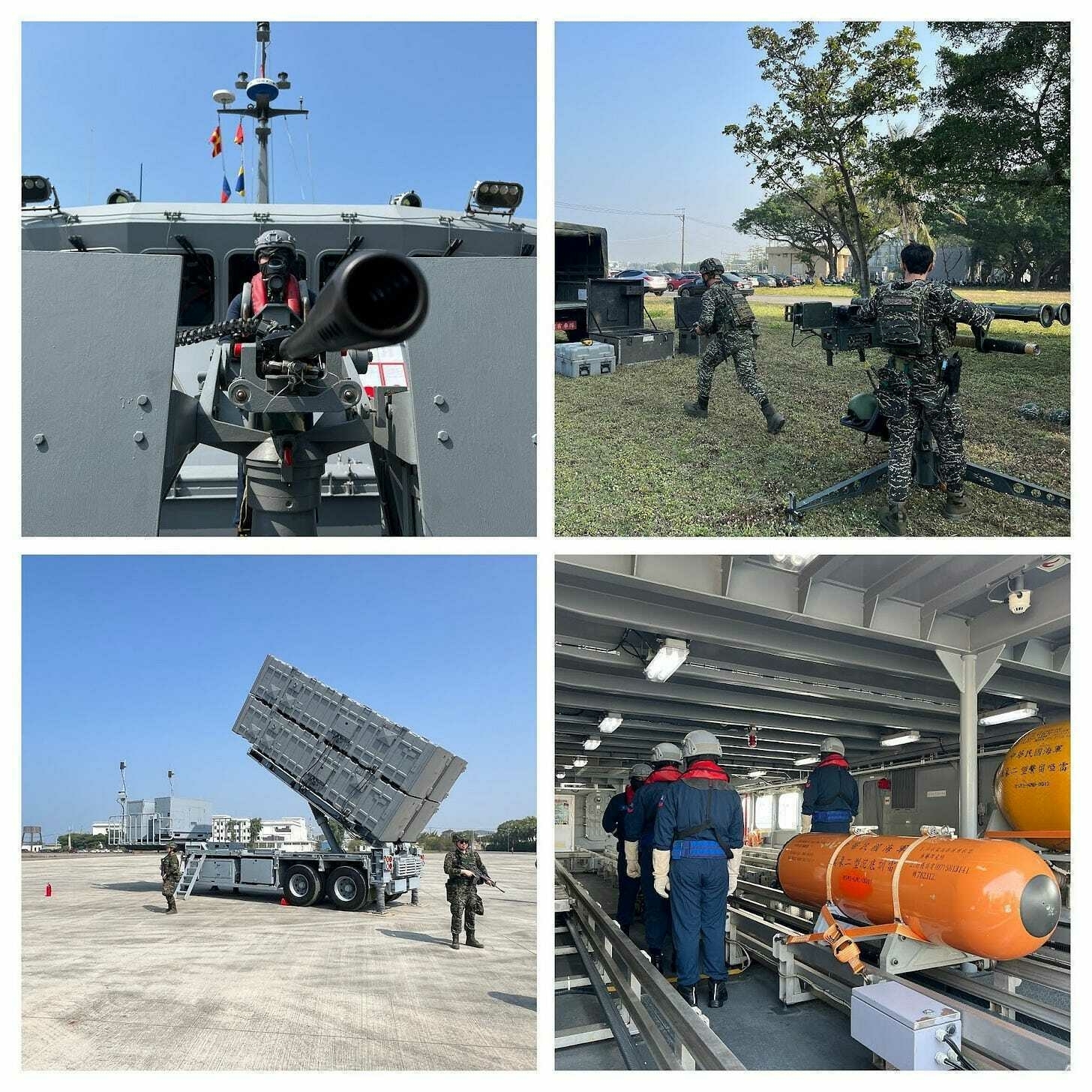
Taiwanese Navy, Army and Marine Corps engage in military exercises as The Counteroffensive looks on. Clockwise from top left: a sailor stands ready at a machine gun; marines perform exercises; troops practice an air defense drill; and sailors prepare to launch a naval mine. Lieutenant Commander Lian Shaopu, head of an eight-boat squadron, is training his people to deploy sea mines to locations that the enemy could use to reach the island.
The goal is to slow down and disrupt a hypothetical Chinese offensive. Every week, their crews get together to understand the type of mines they are working with, he told The Counteroffensive.
The Air Defense Battalion has also included twin-mounted Stinger missiles, also known as the Dual Mount Stinger, into their training.
Marine Staff Sergeant Bao Wei Zhong, who has been in the military for 10 years, told The Counteroffensive that these weapons can fire two missiles simultaneously, enhancing air defense capabilities against targets such as helicopters.
A Taiwanese fighter jet pilot prepares to board his plane.The Taiwanese public would be willing to defend the nation amid a Chinese attack, but the majority believe Beijing will not invade the island within the next five years, a poll conducted by Taipei think tank, the Institute for National Defense and Security Research, revealed.
However, Ming Zhong thinks the stakes are high. “As long as China remains undemocratic, they will always try to invade us. It’s only a matter of time.”
Approximately 68 percent would be willing to defend Taiwan. In addition, 64 percent said China’s “territorial ambition” poses a “serious threat” to the island. Yet, 61 percent said it was unlikely that the People’s Liberation Army would invade in the next five years.
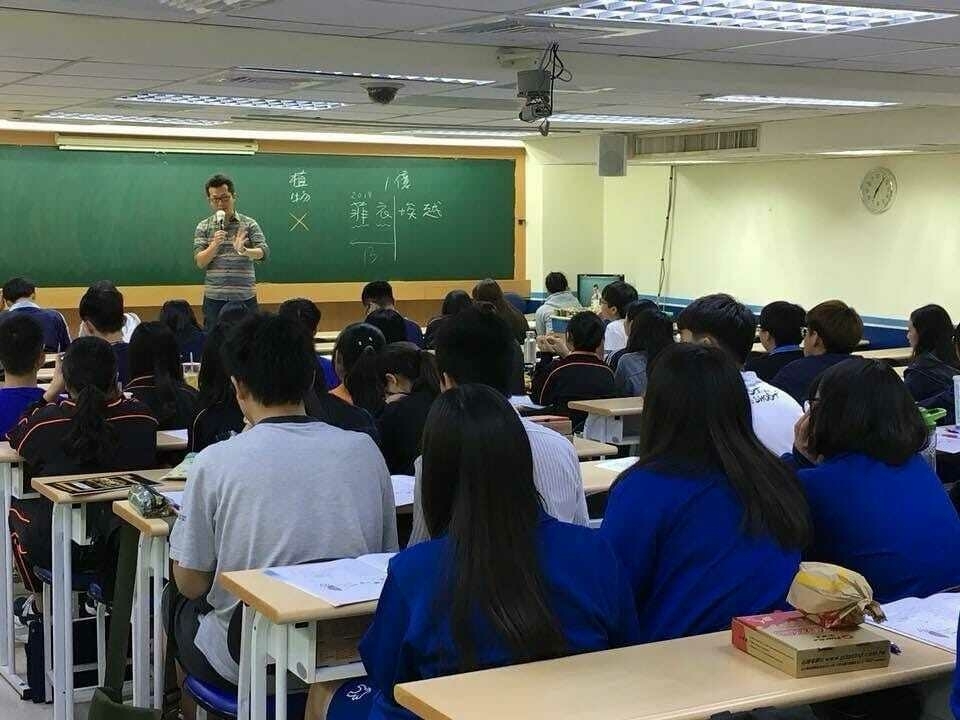
Ming Zhong, who has devoted his life to education and helped Taiwanese kids, teaches geography in his class. For Ming Zhong, a Chinese invasion feels inevitable. As a communist state that restricts individual freedoms, the Chinese Communist Party sees democratic Taiwan as a threat, as its very existence could inspire Chinese citizens to imagine life in a free society.
In the meantime, Ming Zhong continues to share his expertise with his students, teaching them about Taiwan’s natural defenses.
Ming Zhong has been devoted to helping the next generation in Taiwan. One of the things he teaches his students is that they should never run away from their problems.
If the war comes, Ming Zhong will do everything to protect his motherland.
“We need to fight a war that wins the respect from the world. We need the world to understand us and stand for our country, even if the cost is high,” said Ming Zhong.
NEWS OF THE DAY:
Good morning to readers; Kyiv remains in Ukrainian hands.
TAIWAN TESTS NEW WEAPON INSPIRED BY UKRAINE: Taiwan has begun testing a new weapon that could bolster its defenses against a potential Chinese invasion: sea drones.
Inspired by Ukraine’s successful deployment of sea drones in the Black Sea, Taiwan is exploring this low-cost, high-impact technology to strengthen its maritime security. The remotely operated drones can carry explosives and are capable of targeting both ships and aerial threats.
“Uncrewed boats or vehicles have played a very significant role in the Ukraine war,” Chen Kuan-ting, a lawmaker from Taiwan’s ruling Democratic Progressive Party, told Reuters.
CONGRESS URGED TO RESUME SEARCH FOR DEPORTED KIDS: 30 members of Congress from both parties issued a letter to Secretary of State Marco Rubio, urging him to maintain funding for the Conflict Observatory at Yale University’s Humanitarian Research Lab, which helps locate Ukrainian deported children.
Elon Musk’s Department of Government Efficiency (DOGE) shut down the program at the end of January. After being forcibly shut down, Yale researchers lost access to a database of 35,000 children they had compiled over three years. Although the database was eventually handed over to Europol, the EU’s law enforcement agency, lawmakers have warned that the data could become outdated within weeks.
Nathaniel Raymond, the head of Yale’s researchers, told The Counteroffensive earlier that without HRL's work, Ukraine will lose access to four crucial capabilities:
Whereabouts of children that have been taken for re-education, adoption, military training, or similar purposes;
Names/files of children who have been made Russian citizens;
Number of children believed to have been sent to Russia for re-education; and
Forensic analysis of documents detailing how Russia makes these children citizens.
Moreover, according to the lawmakers’ letter, few organizations possess the same level of expertise in open-source investigations, collecting photos and videos of deported children, and working with Russian websites.
RUSSIAN OIL PRICES SURGE AFTER ISRAEL-IRAN STRIKES. Russian oil prices surged after Israel’s attacks on Iran raised fears of global supply disruptions, marking the largest intraday gain since the day after Russia’s full-scale invasion of Ukraine in 2022.
Until Friday, Moscow’s oil revenues had been falling, with prices slumping below the $60-per-barrel price cap. But the renewed volatility sparked a rally on Russia’s stock exchange, with domestic oil and gold companies posting significant gains.
U.S. OPPOSES LOWERING RUSSIAN OIL PRICE CAP. The United States is resisting efforts to lower the G7 price cap on Russian oil, despite mounting pressure from European allies.
Ahead of the G7 summit, Bloomberg reports that sources familiar with the matter say the Trump administration opposes reducing the cap from $60 to $45 per barrel.
The cap, introduced in December 2022, was designed to curb Moscow’s oil revenues and weaken its ability to fund the war. It bars Western firms from purchasing Russian crude above $60 per barrel.
Despite U.S. resistance, other G7 members are reportedly prepared to move forward with the proposal without Washington’s backing.
DOG OF (PREPARING FOR) WAR:
A stray dog runs across military parade grounds before a Taiwanese Army drill. It did not stop to tell us his name!
Stay safe out there.Best,
Tim -
Trump gave Putin a ‘two-week’ deadline to consider peace in Ukraine. Instead, Russia just launched more drones.
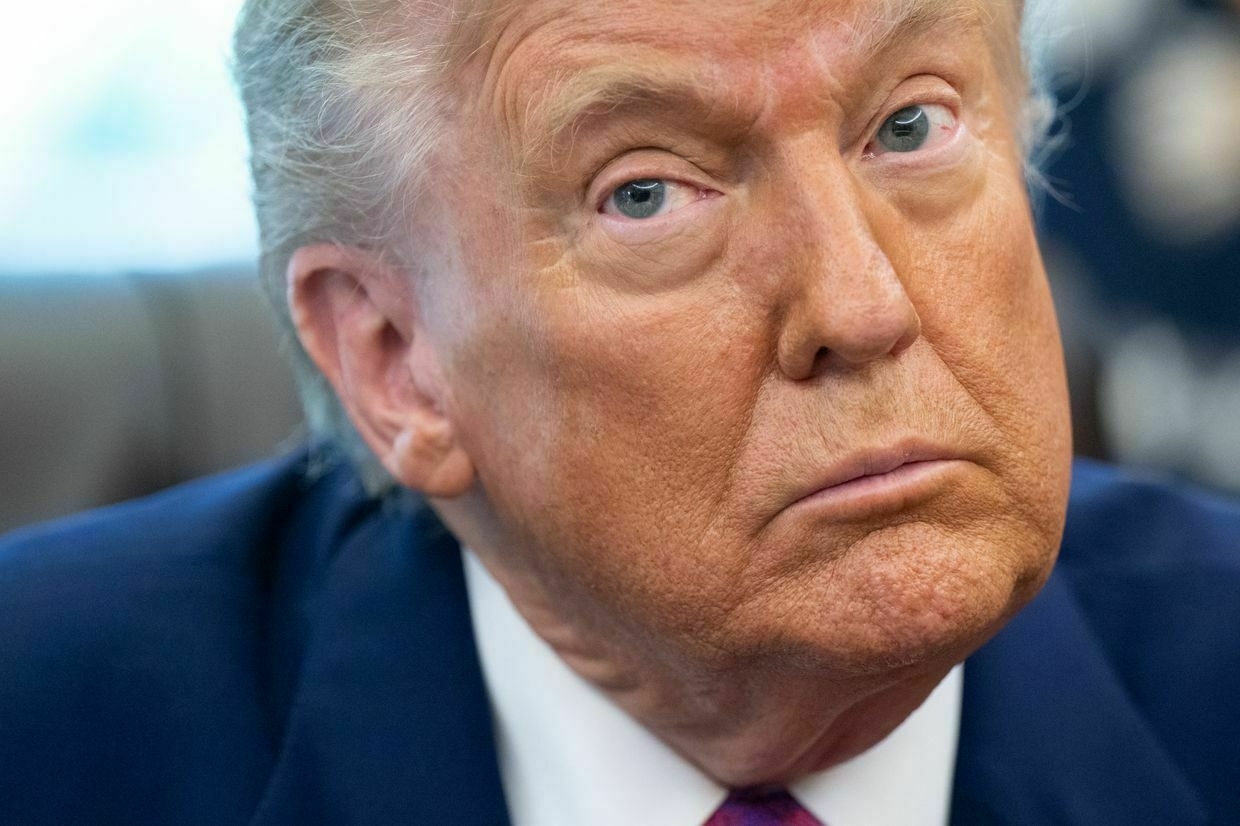
A “two week” deadline imposed by U.S. President Donald Trump to see if Russia is serious about peace in Ukraine has been and gone, with Moscow’s escalation of attacks on civilians during this period failing to draw the slightest condemnation from the White House.
“We’re going to find out very soon. It’ll take about two weeks, or a week and a half,” Trump told reporters on May 28, responding to a question on whether Russian President Vladimir Putin wants to end the war.
His comments came two days after Russia carried out the biggest drone attack of the full-scale war, which reportedly involved 355 Shahed-type attack drones and decoys.
Since the deadline was imposed, this record has been broken twice — Russia attacked Ukraine overnight on June 1 with 472 Shahed-type attack drones, and on June 9, 479 drones and 20 missiles were launched against Ukrainian cities.
The figures are stark. In March 2025, Russia launched 4,198 drones at Ukraine, which is so far the largest monthly number of drones launched during the full-scale invasion.
But if the intensity of attacks so far in June continues, that figure could reach nearly 7,000.
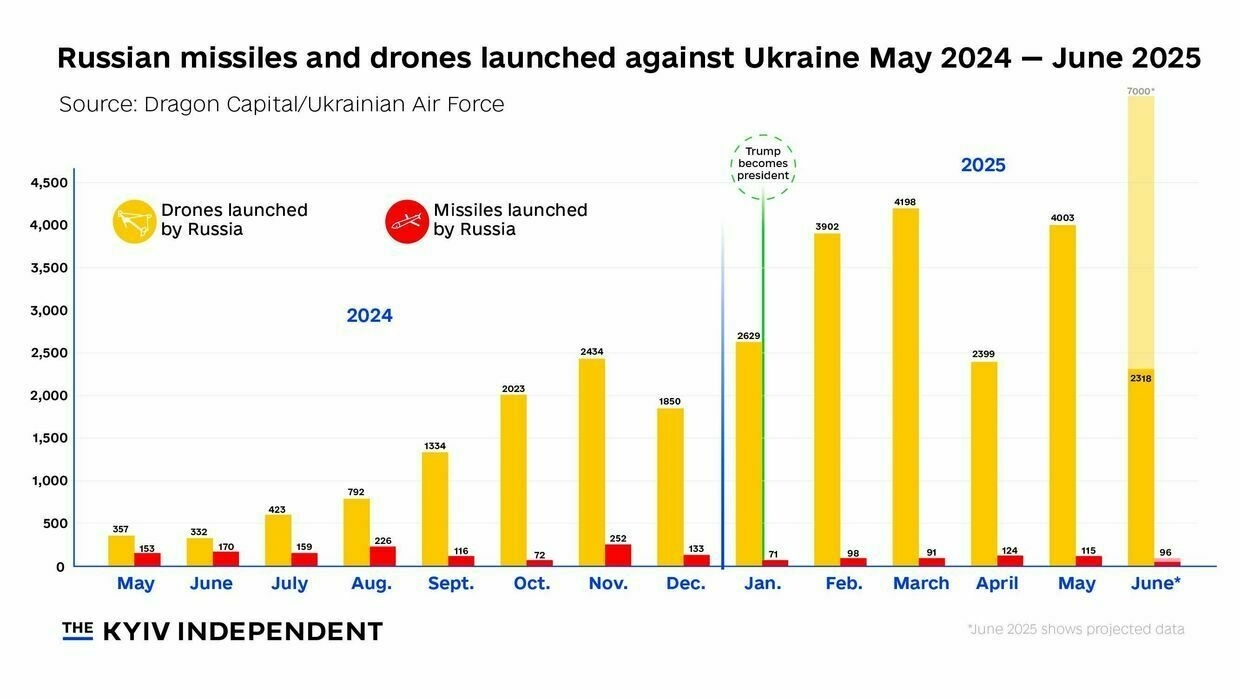
Russian missiles and drones launched against Ukraine May 2024-June 2025. (Nizar al-Rifai/The Kyiv Independent) “This is terrorism against the civilian population aimed to create a sense of doom, war-weariness, and to put pressure on the (Ukrainian) authorities,” Rodion Rozhkovskiy, co-founder of Liveuamap, told the Kyiv Independent.
Despite previously hinting at the imposition of new sanctions against Russia if the Kremlin doesn’t show a desire to end the war, Trump has so far taken no action against the ongoing escalation of violence by Moscow’s forces.
“Lately, every attack instills a huge fear that does not disappear until the air alarm is over.”
Instead, Trump on June 6 excused Russia's escalating attacks, saying Ukraine's Operation Spiderweb, an attack on Russian bomber aircraft, "gave Putin a reason to go in and bomb the hell out of them."
Operation Spiderweb was a clinical strike against legitimate military targets. Russia's drone strikes indiscriminately target civilians, illegal under international law.
On June 12, for the first time since the launch of the full-scale invasion, U.S. Secretary of State Marco Rubio released a statement to mark Russia Day.
"On behalf of the American people, I want to congratulate the Russian people on Russia Day," Rubio said.
"The United States remains committed to supporting the Russian people as they continue to build on their aspirations for a brighter future."
Meanwhile in Ukraine, a brighter future for those living in cities under near-nightly bombardment by the Russian people seems far out of reach.
"Lately, every attack instills a huge fear that does not disappear until the air alarm is over," Kyiv resident Oleksandra Pshenychna, 20, told the Kyiv Independent.
"The worst feeling that comes is despair accompanied by a sense of emptiness, inevitability, and hatred for those people who are behind the launch of Russian drones and missiles into residential buildings, cultural monuments, and crowds of people," she added.

Ukrainian civilians injured in Russian attacks May 2024-May 2025. (Nizar al-Rifai/The Kyiv Independent) 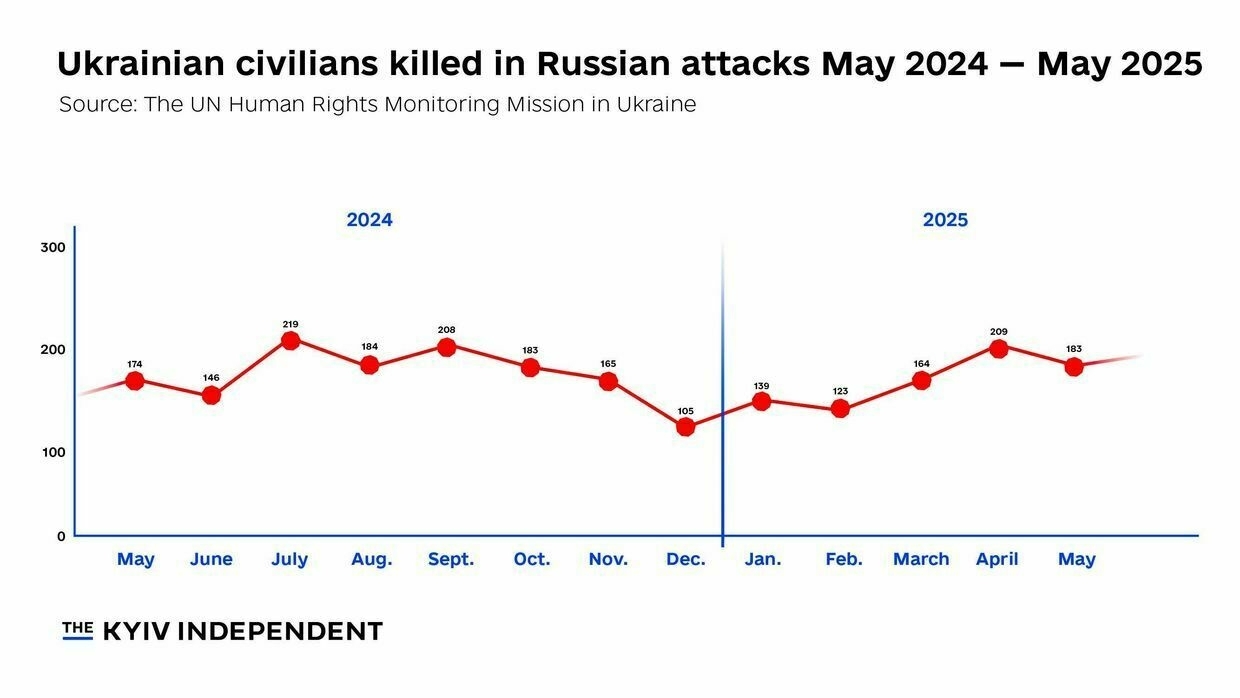
Ukrainian civilians killed in Russian attacks May 2024-May 2025. (Nizar al-Rifai/The Kyiv Independent) Russia's disregard for Trump's statements and threats long predates his two week deadline — data on Russian drone strikes clearly indicate that despite the U.S.-led peace process initiated after Trump took office, Moscow has launched larger drone attacks on civilians than it did during the presidency of Joe Biden.
This is despite Trump's multiple promises to end the war in 24 hours, which then turned into 100 days. Trump has now been in office for 144 days.
His search for a peace deal has seen a flurry of diplomatic meetings around the globe, severe and sustained pressure on Ukraine, and a reluctance to force any concessions from Russia.
During this time, Russia has continued to attack Ukraine on a daily basis. Ahead of the second round of direct peace talks held in Istanbul on June 2, Russia killed 9 civilians and injured 49 others.
"They [russians] are using all they can use — if they could use more, they would use more."
Kharkiv resident Mykola Zhydkov told the Kyiv Independent that he has noticed that particularly heavy bombardments often actually coincide with peace process-related events that the White House portrays as positive steps towards a potential ceasefire.
"On June 10, POWs were swapped. On the same night, Kharkiv suffered a major attack," Zhydkov said.
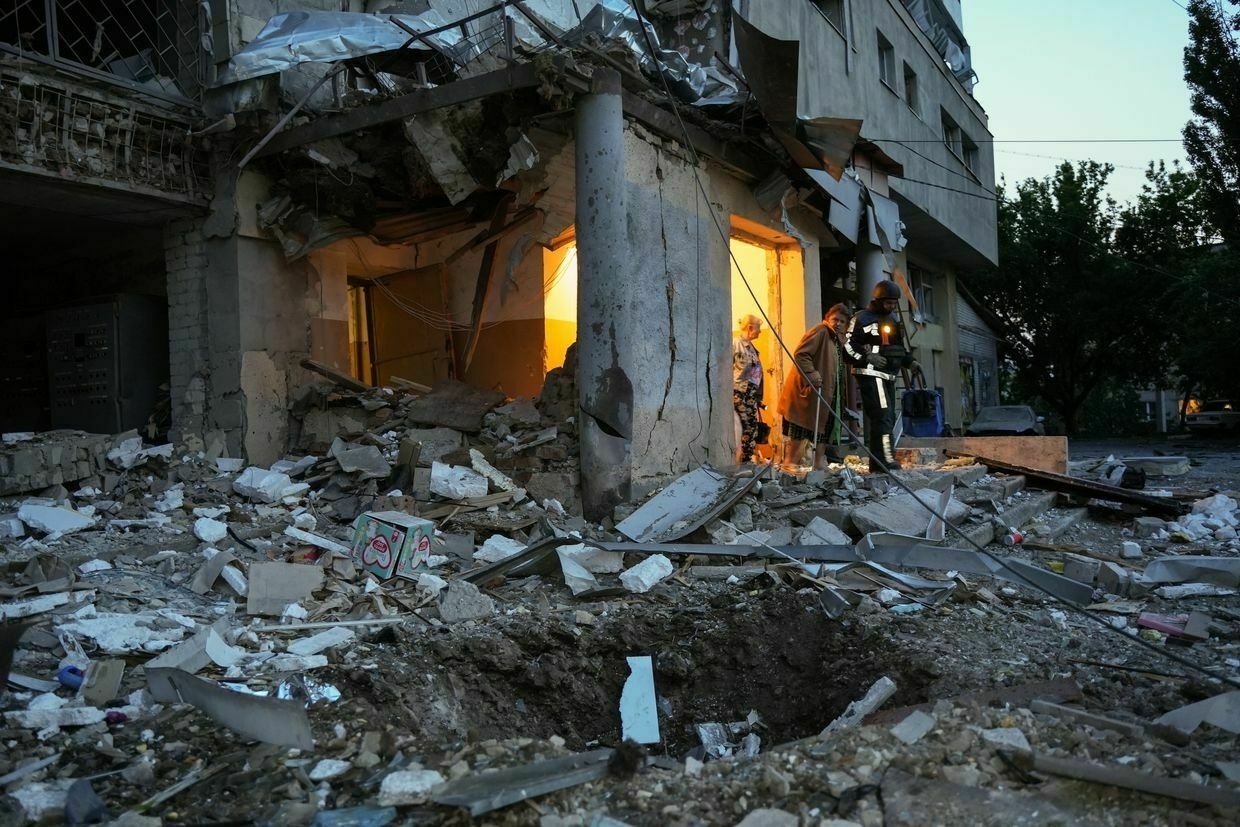
An elderly woman walks with the help of a rescuer amid rubble from a damaged residential building after a Russian drone attack in Kharkiv, Ukraine, on June 12, 2025. (Viacheslav Mavrychev / Suspilne Ukraine / Global Images Ukraine via Getty Images) With Trump so far failing to respond to Russia's escalating drone strikes, the Kremlin has little incentive to stop. All signs point to Moscow's defense industry only increasing its ability to launch ever-larger mass attacks.
According to Rozhkovskiy, the only limiting factor in how many drones Russian can launch in any given attack is how many its factories can produce.
"They are using all they can use — if they could use more, they would use more," he said.
The Russian production surge is being facilitated by imports of components from China and the recruitment of low-skilled labor from foreign countries, including from those in Africa.
Russia is also building new launch sites and will soon be able to deploy more than 500 long-range drones a night to attack Ukraine, a source in Ukraine's military intelligence (HUR) told the Kyiv Independent last week.
Israel-Iran war could provide economic boost Russia needs to continue fight against UkraineIsrael’s “preemptive” strikes against Iran targeting the country’s nuclear program and killing top military officials could have far-reaching implications for Ukraine and could boost Russia’s ability to continue its full-scale invasion, experts have told the Kyiv Independent. Iran has been one of Russia’s staunchest allies throughout the war, providing thousandsThe Kyiv IndependentChris York
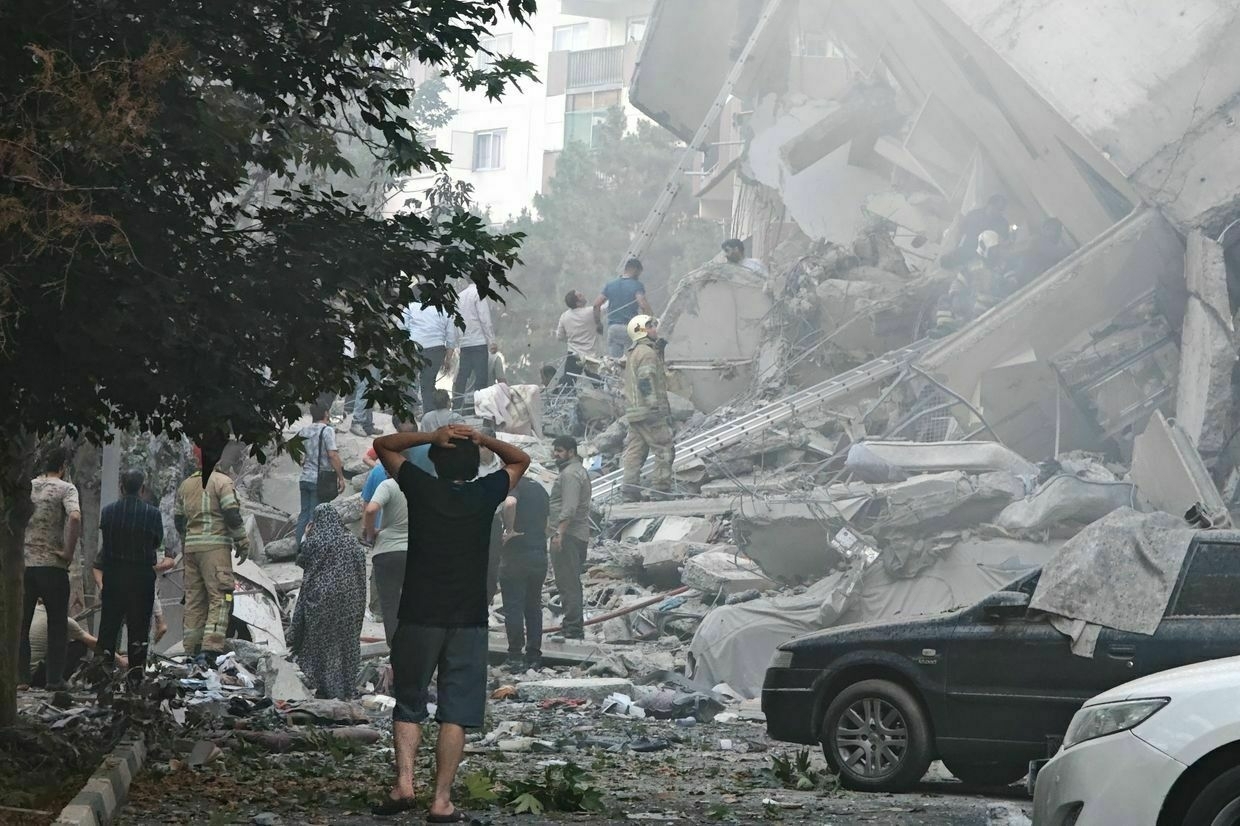
-
Ukraine, Russia conduct fourth prisoner exchange this week

Kyiv is continuing efforts to bring home its citizens held captive by Russia, marking the fourth prisoner exchange in a week, President Volodymyr Zelensky announced on June 14.
“Today, among those returning to Ukraine, many have been in captivity since 2022,” Zelensky said. “These include soldiers from the Armed Forces, National Guard, State Border Guard Service, and the State Special Transport Service."
The exchanges are part of the agreement reached during talks held in Istanbul earlier this month, where both sides agreed to phased prisoner swaps and repatriation of fallen soldiers.
-
Ukraine repatriates bodies of 1,200 citizens in latest swap with Russia

Editor’s note: This is a developing story and is being updated.
Ukraine has recovered the bodies of 1,200 fallen citizens, including military personnel, in the latest round of repatriation efforts coordinated with Russia under agreements reached during talks in Istanbul, Ukrainian officials said on June 14.
The Coordination Headquarters for Prisoners of War said the bodies, which Russian authorities claim belong to Ukrainian nationals, were returned as part of an ongoing phased exchange process.
“The remains will now undergo forensic examination and identification procedures conducted by law enforcement investigators in cooperation with expert institutions under the Interior Ministry,” the Coordination Headquarters said in a statement.
Zelensky plans to meet Trump at G7 summit — key takeaways from closed-door briefing“Both teams are working to ensure we meet,” President Volodymyr Zelensky said.The Kyiv IndependentAnna Fratsyvir
